We Asked Gamers About Their Hard Days at Play NYC. Here’s What We Learned.
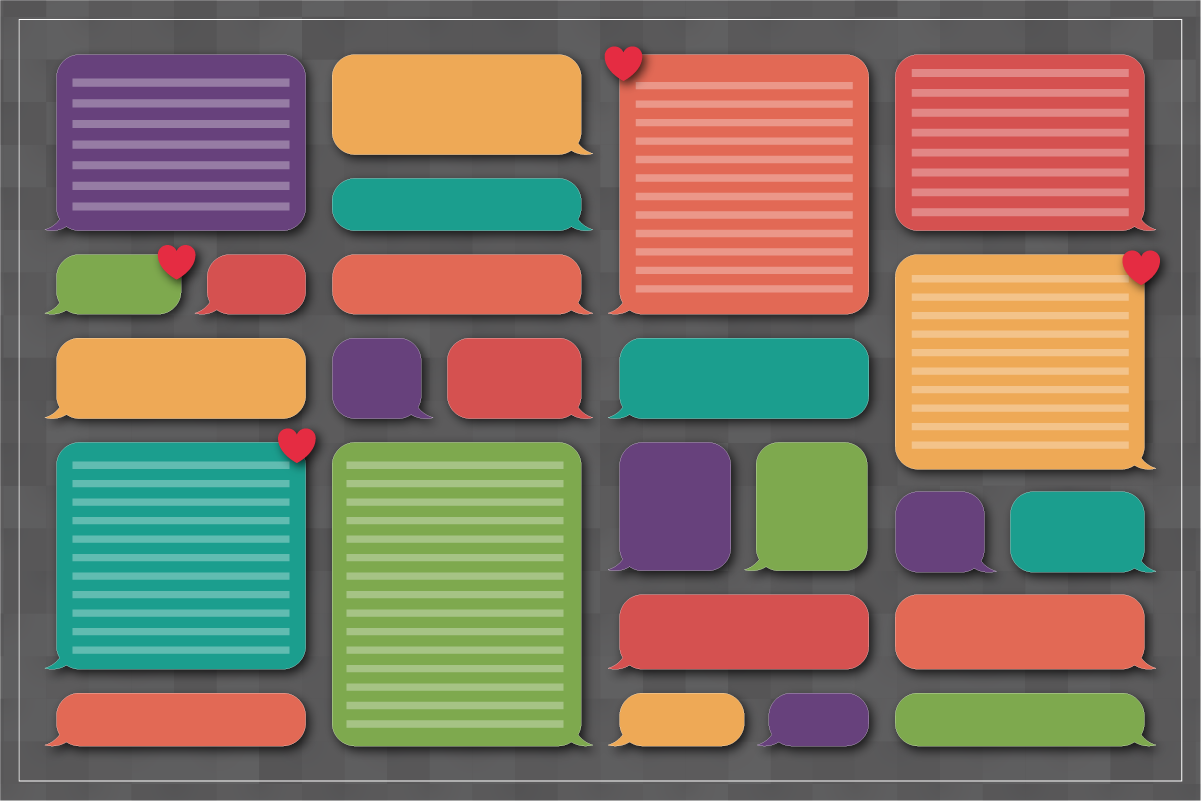
Our ability to feel is what makes us human. It is fundamental to who we are, underlying how we connect and the realities we co-create.
It supports our sense of self, helping us unpack our thoughts and reactions, build awareness of what's happening around us, and deepen our knowledge of ourselves in relation to the world we live in.
Games make us feel. They delight us, challenge us, calm us, frustrate us, connect us, and excite us. They're also uniquely captivating, not just in what they portray aesthetically and demand mechanically, but because of the state of embrace they insist on those who play them. Encountering a never seen start screen or the unopened box of a new tabletop game, we are ready, willing, and receptive to knowledge. Play's ability to get us to put our guard down, be curious, and engage with new possibilities helps create the conditions for transformation and meaningful learning.
Earlier this month, the iThrive team showcased at Playcrafting's Play NYC—an event that magnified the power of play and brought hundreds of game industry professionals, indie game developers, and game designers together to exhibit their games to players and peers. There, we shared Cadence, a single-player, text-based strategy game we created with the One Love Foundation and Playmatics, LLC. Cadence invites players to explore three of their friends' stories and converse with them via real-time dialogue choices that affect their friendships and outcomes. Building on One Love's mission to empower young people with the life-saving prevention education, tools, and resources they need to see the signs of healthy and unhealthy relationships, Cadence supports young people in learning to love better, in being with partners who practice healthy love, and communicating with loved ones who are in unhealthy relationships. While New Yorkers of all ages played a demo of the game and shared feedback, teens, many of whom went on to become members of our Teen Hub, were particularly moved by the game's storyline, mechanics, and captivating 2D art.
Beyond the valuable feedback we received on Cadence, slated for release later this year, the experience provided another opportunity for our team to create a forum for listening to and learning from young people. At PLAY NYC, we marked a large glass bowl with the question, "What makes you feel better on your hard days?", and teens and young adults anonymously shared the following:
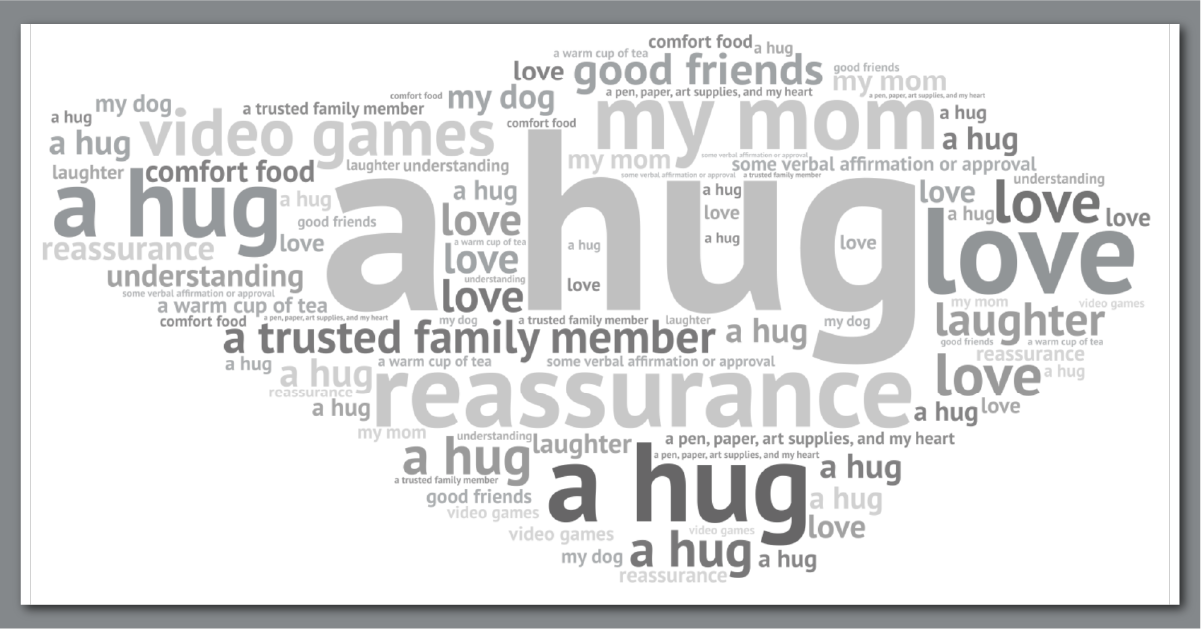
ARE WE LISTENING?
Tucked in each of these answers is a guidepost for innovation—caring, joy, connection, self-expression. Creating safe spaces where teens are heard and listened to with the intent to understand them has guided our game development and experience design work over the last five years, and empathic listening and design is what has made the impactful play experiences we've designed with and for teens possible. The needs echoed and desires illuminated in the responses we elicit from young people in the safe spaces our social and emotional learning experts create (in this case, a glass bowl, and lime green Post-it notes) are folded into the game concepts we envision with clients and collaborators
Empathic listening has long been a driver of breakthrough thinking. Being in community with teens and young adults has helped us think expansively and collaboratively. We've found that empathy, when practiced consistently, is essential to transformative change and central to the knowledge-building and knowledge-sharing that informs the design of meaningful solutions.
iThrive's co-design approach, which gives teens the tools to step into their genius and explore their needs, is care in action. Our approach creatively empowers young people with new ways to tap into their genius, share their experiences and wisdom with others, advocate for the support they deserve, and create with us the experiences they want to see.
With the Centers for Disease Control and Prevention (CDC) reporting that nearly half of U.S.-based high school students are experiencing persistent feelings of sadness and hopelessness, it is on all of us in the game design ecosystem to create the spaces, in person and digital, to listen and effectively gauge the thriving of end users. With over 90 percent of teens and young adults self-identifying as gamers, every game designer, developer, and writer has the tools to meet them where they are and equip them with valuable knowledge, tools, and support. It is on all of us always to ask, "Are we listening?"
ARE WE SUPPORTING?
The learning that comes from listening allows all designers and developers to respond constructively, and offer support in meaningful ways. Games are already socially and emotionally valuable, and when tailored to teens and young adults' strengths, developmental needs, and insights, they become vessels for further social and emotional support.
Our adolescent development experts work with and for young people, and in partnership with libraries, museums, government agencies, and organizations that care about them, fully recruit the feelings that play evokes to support teens' social and emotional health. The science of adolescence and evidence-based practices that support positive teen growth are folded into the games, game-based tools, and interactive learning experiences we create. Questions like "How does this enliven teens to practice healthy skills like exploring their identity, engaging with their community, and taking purposeful action in the world?"; "How does this invite teens to regularly notice emotions, helping them notice the thoughts, sensations, and behaviors that accompany their feelings?"; or "How does this normalize help-seeking?" steer the game development process we lead, ending in a play experience that nourishes young people in ways supportive of their wellness, learning, and thriving.
At Play NYC, we shared questions like these on a printout version of our 10 Things to Know When Designing for Teens resource, given to other game designers and developers eager to go beyond listening and to start responding and supporting young people's social and emotional needs. We're happy to now make that resource accessible to everyone and downloadable via the Resource Hub on our website.
Asking and listening helps us understand people and ideas. That insight and evidence-based practices nudge us toward wellness-supporting games and more impactful play experiences for young people. For the design team or studio looking to elevate the impact of the games they create for young audiences, connect with us today for a consulting report benchmarking your game in development against the science and sharing recommendations on ways to fold in social and emotional skill-building—a practice proven to protect and promote teen mental health.
Together, we can and should advance wellness wherever young people are. Join in.
The Teen Mental Health Crisis is Real. Game Designers & Developers Can Help.
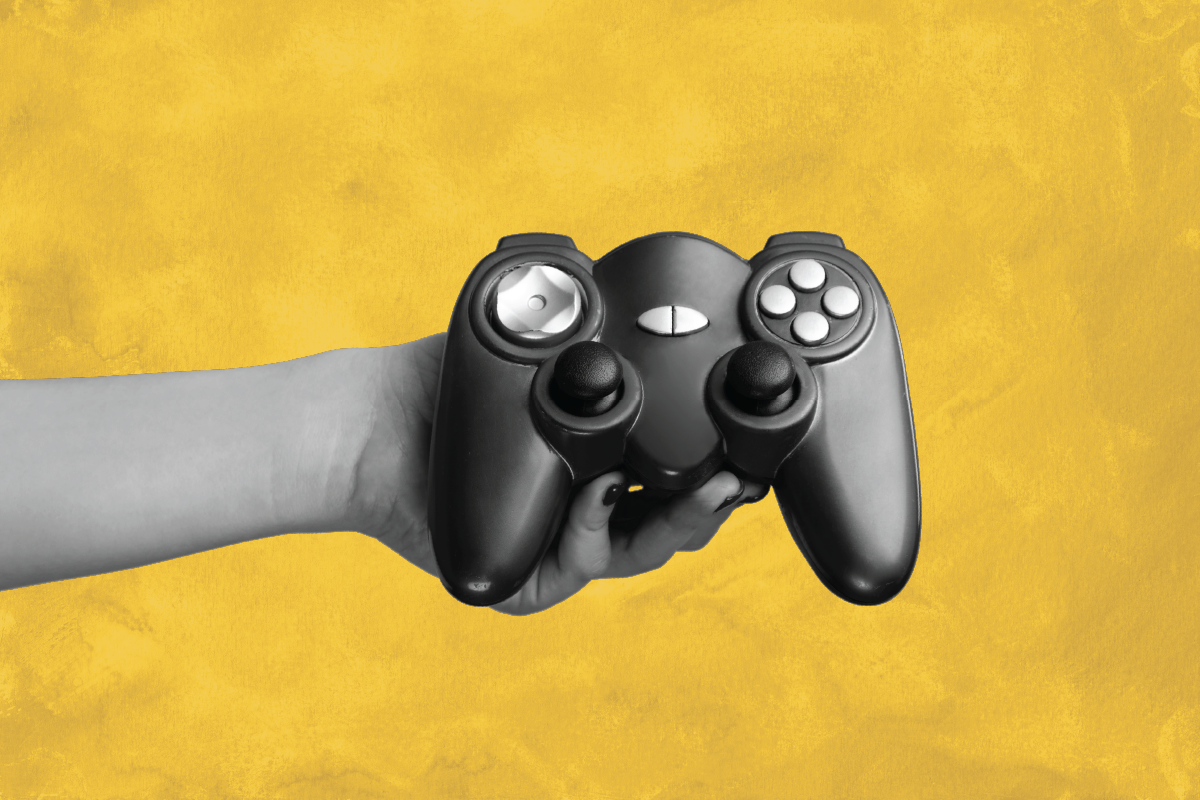
This post is the last in our five-part series, Supporting Teen Mental Health, which shares tools and insights that support educators, parents, and youth-serving adults in showing up for teens in this moment of need. Read earlier posts in the series about mindfully managing difficult emotions, using social media actively and intentionally, nurturing the teen brain with school-based social and emotional learning opportunities, and applying culturally responsive approaches in therapeutic interactions with teens.
Veteran game designer, Jason VandenBerghe, wrote for iThrive Games in 2018 that "If we want to make a large, positive change in our world, I believe the best route is to focus on providing teens with better models for the world." If teens needed better models for the world four years ago, how much more do they—and all of us—need them in 2022?
This month alone, two 18-year-olds separately made the ruinous decision to commit mass murder—one in a racially charged event in Buffalo, NY, and the other in Uvalde, TX. U.S. teenagers wake up every day to more evidence of gun violence, societal strife, greed and corruption in places of power, shrinking opportunities for financial security, and the threat of climate catastrophe. It's no small wonder that rates of mental health struggles among teens are higher than ever.
Video games and social media are too often the easy scapegoats for teens' mental health challenges. In reality, the impact of digital technologies on youth mental health and well-being is complicated, and conclusions in the research are mixed. We know that's largely because "digital technologies" vary as widely as the teens who use them and the circumstances in which they're used. Of course, playing video games under some conditions can be disruptive to the healthy functioning of some, and can facilitate the healthy functioning of others. So, what's the responsibility of a game designer or developer?
At iThrive, we value and know that it is both possible and imperative to empathize deeply with and design ethically for teens. One of the best ways we've found to do this: Co-design with teens the digital tools they use. A youth-centered approach to digital technology design is among the recommendations put forth by the U.S. Surgeon General in his Advisory on Protecting Youth Mental Health. When we design with teens, for teens, the digital experiences they engage with are both likelier to do no harm at this vulnerable developmental moment, and likelier to amplify teens' immense capacity to thrive emotionally, socially, cognitively, and physically.
There's so much that's fascinating and motivating about the teen brain and how it's changing. For designers, we've boiled it down to a list of 10 things to know when designing for this unique window of both opportunity and vulnerability to best support teens' mental health.
TEENS ARE:
-
BUILDING HABITS FOR LIFE: Teens' brains are undergoing the last major restructuring of development, making the teen years the perfect time to build skills and habits that help them throughout life. But negative habits "stick" more at this time, too.
-
CATCHING ONTO YOU, FAST: Teens are getting wiser about the world. They're reaching a cognitive peak and learn very quickly. They easily see through attempts to manipulate or preach to them and don't respond well to hypocrisy or unfairness.
-
IN NEED OF POSITIVE CONNECTIONS: Above all, teens need access to strengthening experiences, environments, and relationships that help them grow in positive ways. They want to be close to adults, even as they figure out how to be more independent.
-
MORE TOLERANT THAN TEENS USED TO BE: Teens today value diversity and acceptance even more than previous generations. They care about authentic inclusion and diversity.
-
NOT JUST "WEIRD:" Obvious, but worth remembering, teens aren't just Western, Educated, and from Industrialized, Rich, Democratic countries. They need their uniqueness and diversity to be reflected in the spaces where they spend time.
-
SENSITIVE TO REWARDS, ESPECIALLY SOCIAL ONES: Teens have more dopamine circulating in their brains than adults. They are very sensitive to "feel-good" rewards like those in video games. Teens do riskier things when other teens are around, partly to earn status and respect.
-
STILL LEARNING TO CONTROL IMPULSES & EMOTIONS: Teens are still developing connections in the prefrontal cortex. They have a more challenging time controlling impulses and emotions and predicting the consequences of their actions than they will in the future.
-
IN NEED OF MORE SLEEP: Teens need more sleep than adults to thrive, and they might need support to make the best choices and set boundaries for their health.
-
FACING A LOT OF STRESS: Teens are under a ton of pressure. Also, if they are going to appear, most mental illnesses show up between early adolescence and young adulthood. Teens need ways to cope and to be able to seek help without stigma.
-
TRYING TO FIGURE OUT WHO THEY ARE: Teens want to try on different roles and expressions and figure out where they belong. They need social spaces to interact, experiment, negotiate, and resolve conflicts. But toxicity and bullying should be proactively prevented in these spaces.
So, if you're a designer or developer of experiences teens use, how much do you think about their needs at this developmental moment? What models of the world are you making for them? And are teens a part of your design process?
Creating spaces that foster teens' mental health and well-being is a team effort. iThrive is here to support you. We offer Game Design Kits, evidence-based guides to designing for mental health, and specific components of teen thriving like growth mindset and zest. We also specialize in custom design services that draw on teens' genius and creative problem-solving energy. Reach out to find out how you can use our co-design approach at your studio or organization.
One Thing Mental Health Practitioners Who Work With Teens Must Know

This post is the next in our series, Supporting Teen Mental Health, which shares tools and insights that support educators, parents, and youth-serving adults in showing up for teens in this moment of need. Read earlier posts in the series about mindfully managing difficult emotions, using social media actively and intentionally, and nurturing the teen brain with school-based social and emotional learning opportunities.
Teens' mental health difficulties and needs have peaked since the start of the pandemic, culminating in what leading U.S. child and adolescent health organizations have deemed a national emergency. As mental health practitioners strive to meet diverse teens where they are at this time of crisis—in part one spurred on and exacerbated by racial inequities—they need tools and approaches that offer authentic entry points for building rapport and trust.
The U.S. Surgeon General's 2021 Advisory, Protecting Youth Mental Health, stresses the need to "recognize that a variety of cultural and other factors shape whether children and families are able or willing to seek mental health services. Accordingly, services should be culturally appropriate, offered in multiple languages (including ASL), and delivered by a diverse mental health workforce." Using culturally appropriate tools and approaches invites teens and their families to engage as equal partners in improving and maintaining young people's mental health. Critically, this approach also amplifies and celebrates existing strengths and connections that are unique to each young person's cultural background and social network.
At iThrive, we've witnessed how games can be a powerful part of culturally responsive approaches to supporting teens' social and emotional skills, which are critical for mental health across the lifespan, both in schools and in therapeutic settings. That's because games of all kinds have the power to tell compelling stories, not just about the characters within them but about the players who play them, revealing truths about who they are and the world they inhabit. As one high school senior said of iThrive Curriculum: Museum of Me, our unit based around the game What Remains of Edith Finch: "You learn some things about yourself and others. It's nice to know that your [sic] not alone in seeing yourself a certain way. It's kind of relieving to know other people feel the same ways about themselves."
In an effort to help youth-serving practitioners better support teens with culturally responsive tools and approaches, iThrive's Senior Director of Learning Michelle Bertoli interviewed Lora Henderson, a licensed clinical psychologist, former educator, and assistant professor at James Madison University who specializes in supporting the mental health of young people in underserved populations. In the interview transcribed below, she shares best practices and tools — including game-based approaches — for engaging authentically with diverse teens in support of their health and healing. The interview has been edited for length and clarity.
Michelle: In your own work, how do you identify and define culturally responsive tools and practices?
Lora: I work at the intersection of education, mental health, and social and emotional learning. I define culturally responsive practices, or CRPs, as actions practitioners can take to build on students' strengths and cultural frames of reference. In the classroom, this might mean drawing connections between the curriculum and students' home lives and cultural experiences. In a clinical setting, it might include showcasing materials, games, books, and posters that reflect students' cultural backgrounds and experiences.
Michelle: And how do you get a sense of what's going to be culturally relevant and useful to students? It takes time to get to know them and you don't want to make assumptions.
Lora: Yes, that can be difficult because you don't want to fall into stereotypes about groups. We often go into our interactions with children and families with our own biases and assumptions about their cultural groups. Sometimes those things map onto their experiences and other times they don't. So, I do a lot of building relationships with kids, asking them what they did over the weekend, how their family celebrates holidays. Those small things aren't therapy, per se, but are really important to getting to know kids and their families and what culture means to them and looks like in their own contexts.
Michelle: At iThrive, we design our games and game-based tools with equity, representation, and accessibility as core pillars. From a practitioner's perspective, how do these design principles make a difference for supporting teen mental health and well-being?
Lora: We can expect youth to have improved outcomes when they can connect to the materials, games, or information being shared with them. When we design with youth, put them at the center, and make them experts, like everyone at iThrive really does, it can maximize positive youth engagement with the tools you're creating. At iThrive, it's a bidirectional process: the youth designers get to build social and emotional skills and increase their well-being, and peers who play the games also get to learn from the youth designers' expertise and experiences. That process can have large positive effects for the designers and their peers alike.
Michelle: What tools, including games or game-based approaches, do you use to strengthen young people's awareness and embracing of their cultural identities?
Lora: From my time as an elementary school teacher to my current role as an assistant professor and licensed clinical psychologist, my first job is to build rapport and authentic relationships with youth. All of the other positive outcomes are couched in that initial positive relationship that creates a safe space for youth and families to feel accepted. That's how I demonstrate my respect, openness, and acceptance of their cultural identities. In my classroom and therapy office, I ensured that the books, pictures, and posters reflected the diversity of my clients so that youth could see themselves in my office and know that it was a safe space to be themselves.
In therapy, I play lots of tabletop, board, and card games with youth. As one example, I've played a lot of Spades with Black families who play it at home, to bring an aspect of their culture into the room. I have emotions/feelings playing cards, so as we're playing Spades, and they get a "9" with an angry face on it, we talk about times when they were angry or observed someone else being angry, and how they managed those feelings. I really like to incorporate games that youth are already playing and then infuse mental health and social and emotional components into them. In in-patient settings, youth have taught me card games that they learned while in the hospital or juvenile detention. I let them lead the play. It's one way I demonstrate that I accept and value their lived experiences.
Michelle: How has embracing your own cultural identity as a practitioner helped you hone your professional skills? How have games played a role in this?
Lora: As a Black woman, I have had to examine my own biases and experiences to help me acknowledge the systemic racism that I experience in this country AND the privileges that I have as an employed, cisgender professional with a doctoral degree. While games have to be facilitated thoughtfully and in a sensitive way, gameful activities like "Step in the Circle," "Cross the Line," "Four Corners," and the "Privilege Walk" have helped me with my own personal exploration. I have moved away from the "Privilege Walk" activity because it visually moves privileged individuals ahead and those with less privilege behind and can perpetuate bias, but it was a meaningful activity for me when I did it about 10 years ago. It was the first time that I was really able to reflect on my privileges and challenges as a Black woman. The other activities that I mentioned still have the visual component of stepping into the circle, crossing the line, or going to the corner that aligns with youth experiences, but they remove the cumulative visual effect of moving further ahead or further behind.
Michelle: How would you recommend other clinicians who are not as practiced in culturally responsive approaches with young people begin to build those muscles?
Lora: The best way to become more culturally responsive is to engage with youth and listen to them. Reading the literature and learning about cultural responsiveness, humility, and competence is important, and still there's nothing like just talking to youth. Inevitably, they'll tell you that it doesn't work exactly how it's explained in textbooks or scholarly articles.
But before talking to youth, anyone who wants to be culturally responsive needs to engage in self-reflection about their own biases and assumptions about people from other cultural groups. It can help to have a group that you talk to about these things for accountability and outside perspectives. I can't stress how important doing that personal work is before stepping into work with youth. We don't want them to be our test subjects or to cause unintentional harm by doing things we think are culturally responsive but might be missing the mark and actually doing harm.
Talk to youth about what they like to do, what they enjoy, how they celebrate holidays. Get to know them in an authentic way.
Michelle: How can practitioners manage the fear or uncertainty they may have about making mistakes or unintentionally doing harm when striving to be more culturally responsive?
Lora: I think mindfulness-based techniques are really helpful. If you feel yourself getting nervous or unsure, stop and take a few breaths. Center yourself and remind yourself why you're doing this work. So many of us go from meeting to meeting to facilitating a workshop, etc. Sometimes just taking that breath can help settle your nerves and get you ready for those intersections.
Also, I think it can be fine and even acceptable to acknowledge differences between youth. You can highlight both obvious differences and similarities to help youth notice commonalities they share. Let youth know that you're trying, that you're maybe from a different cultural background and you might stumble, and you want to know about it if you do so you can do better next time. You need a safe space, too, in order to learn when you've made a mistake. It all comes back to authentic relationships because if you don't have that and you miss the mark, youth won't tell you. They might keep trucking along with the program or activity but the outcomes may not be as positive as they could have been.
Michelle: What are some resources you would recommend to practitioners who want to learn more about culturally responsive practices?
Lora: I lean heavily on the Double-Check framework. It's from education but applies in therapy as well. A shorthand tool it uses is the acronym CARES: Connections with curriculum, Authentic relationships, Reflective thinking, Effective communication, and Sensitivity to students' cultures.
For people who want to go even deeper, I also recommend this review of CRPs from an education perspective.
Michelle: Thank you so much for your time and insights, Lora!
[End of Interview]
Mental health practitioners seeking to find new ways to meaningfully engage and support teens from a diversity of backgrounds can also find inspiration in iThrive's Game Guides, which highlight unique ways to check in with teens and touch on their emotional experiences through the lens of some of their favorite games including Minecraft, Fortnite, and Super Smash Bros. Ultimate.
iThrive's Game Design Studio Toolkit is another rich resource for using games as systems to engage teens in complex, aspirational thinking that has its roots in awareness of their unique personal experiences. Individuals who aspire to something even more innovative can also make use of iThrive's design services to envision and realize completely fresh game-based approaches.
What are some ways you use games or game-based approaches in therapeutic interactions with young people? Let us know at contact@ithrivegames.org!
How Social and Emotional Learning Nurtures the Teen Brain
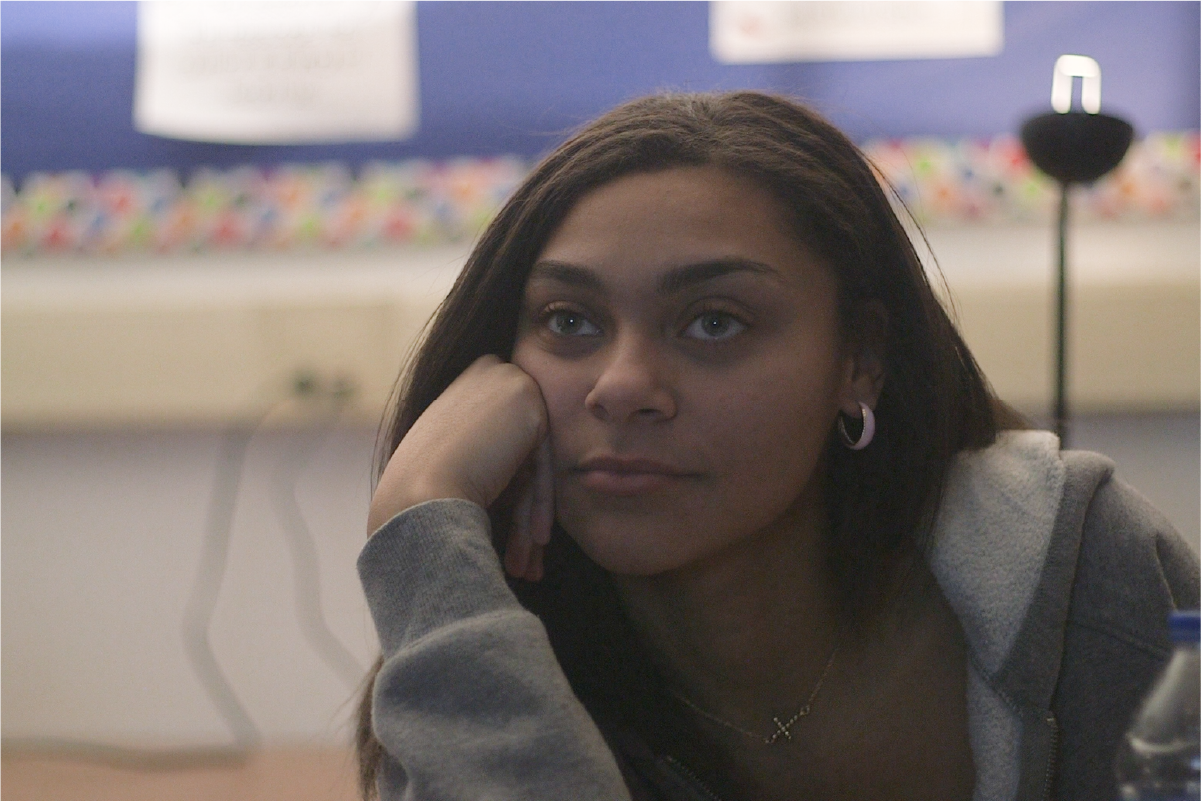
This post is the next in our series, Supporting Teen Mental Health, which shares tools and insights that support educators, parents, and youth-serving adults in showing up for teens in this moment of need. Read earlier posts in the series about mindfully managing difficult emotions and using social media actively and intentionally.
"My understanding of myself changed a great deal."
"I learned how to be a better friend."
"I was able to deal with aspects of myself that I never really had before."
"It's nice to know that you're not alone in seeing yourself a certain way."
Each of these quotes shared by teens is a testament to what happens when schools provide them with meaningful opportunities to actively explore who they are and who they want to be in the world and to build the social and emotional skills that support their mental health and development.
Adolescence is the last major window of neuroplasticity, a time when the teen brain is open to incredible learning potential, on one hand, and heightened vulnerability, on the other. Half of all serious mental health disorders in adults begin by age 14, making early prevention and intervention critical. High quality social and emotional learning interventions have been linked to reduced symptoms of anxiety and depression and lower levels of emotional distress among young people. But even teens who are not experiencing mental health struggles have specific developmental needs when it comes to maintaining and improving mental health. These include having opportunities to figure out who they are, to experience autonomy and independence, and to refine their relationship skills as interactions with both peers and adults in their lives become deeper and more complex. Each of these skills, and many more, are the aim and outcome of quality school-based social and emotional learning efforts.
The U.S. Surgeon General's Advisory on Protecting Youth Mental Health notes the role school communities can play in helping young people find "a sense of purpose, fulfillment, and belonging," supporting them in "managing their mental health challenges." Accordingly, they recommend that educators, school staff, and school districts continue to "expand social and emotional learning programs and other evidence-based approaches that promote healthy development." Mental health supports fall on a continuum of care, and high quality social and emotional learning programs are a "Tier 1" intervention, meaning they provide fundamental coping skills all students in a school community need, even as some students will require more intensive and targeted types of mental health support.
The Advisory mentions that creating the foundation for "a healthier, more resilient, and more fulfilled nation" where young people can thrive begins with creating "accessible space in our homes, schools, workplaces, and communities." To us, "access" means meeting teens where they are developmentally with tools they are familiar with and inviting them to the table when those tools are being developed to share how and what they want to learn. At iThrive, we specialize in creating social and emotional learning experiences that enlist the power of play and respond to teens' unique developmental needs. By design, we prioritize teen voice, personal relevance, and student choice in what we create with and for young people. The genius, creativity, and insight of the teens we work with continues to steer our game and curriculum development work, resulting in memorable and meaningful learning experiences that engage them deeply.
For educators and administrators looking to prioritize their students' mental health, social and emotional learning opportunities and the core skill-building they foster can be a powerful and transformative lever.
HERE ARE THREE WAYS TO ENHANCE YOUR SCHOOL OR DISTRICT COMMUNITY'S COMMITMENT TO SOCIAL AND EMOTIONAL SKILL DEVELOPMENT IN TEENS:
1. CALL SOCIAL AND EMOTIONAL SKILLS WHAT THEY ARE: ESSENTIAL SKILLS.
We've written about it before, and it bears repeating. How we talk about something impacts how it is received and regarded. In a world where polarization and hatred threaten our unity, we can't afford to downgrade competencies like self-awareness, self-regulation, showing empathy and care, effectively advocating for ourselves and others, and making responsible decisions for the greater good to "soft skills." Raising the profile of these core skills to an educational and humanistic priority sets the scene for innovative programming and instruction that responds to and addresses students' needs. To quote a member of our Educator Advisory Council, "Education is not an academic pursuit, it's a relational one. They listen to me because of the relationship, not because I'm the teacher." Meeting social and emotional needs is, simply put, the foundation for effective learning.
2. FIND TOOLS THAT EMBED SOCIAL AND EMOTIONAL LEARNING INTO CORE ACADEMIC CONTENT.
Social and emotional learning efforts are powerful when evidence-based tools are embedded into the content students are already learning, and there's often a natural alignment. Our iThrive Sim role-playing simulation games designed for high school social studies classes, for example, build on the natural synergy between civics education and social and emotional competencies. As students collaborate to make decisions that drive each iThrive Sim scenario forward, they expand their civic knowledge while practicing core social and emotional skills like managing stress, regulating emotions, and making responsible decisions. Likewise, iThrive Curriculum's learning units pair with immersive games to support high school English and humanities educators in discussing self- and social awareness, self-management, and relationship skills with their students. As students work through these curricular units together, the narrative at the center of the game becomes an organic springboard for meaningful reflection and conversations about identity, relationships, and communication.
3. ADOPT AN EQUITY LENS.
Emotions and social connections drive learning. In that sense, social and emotional learning is ultimately about ensuring students' preparedness and ability to learn; all students deserve that fair chance. Implementing high-quality and evidence-based social and emotional learning experiences is a key step toward equity in your school or district community. Taking it a step further, social and emotional learning experiences themselves should be designed with equity and access in mind. iThrive's tools are designed to be representative of and accessible to diverse learners in line with our commitment to equity and universal design for learning principles. Gabbrielle Rappolt-Schlichtmann, an internationally recognized expert in learning science and accessible learning, calls our offerings, "the most innovative, integrated social and emotional learning work I've seen in the high school space."
Social and emotional learning opportunities tend to teens' whole selves. They help young people look inward and deepen their ability to know themselves, name their needs, regulate their feelings and behaviors, and embrace others with empathy and curiosity. Committing to these three practices to support social and emotional learning efforts will meaningfully move school communities toward helping students develop core skills and competencies that support their mental health and emotional resilience, setting them up for thriving far beyond school walls.
Teen Mental Health: Five Tips for Making the Most of Your Social Media Use
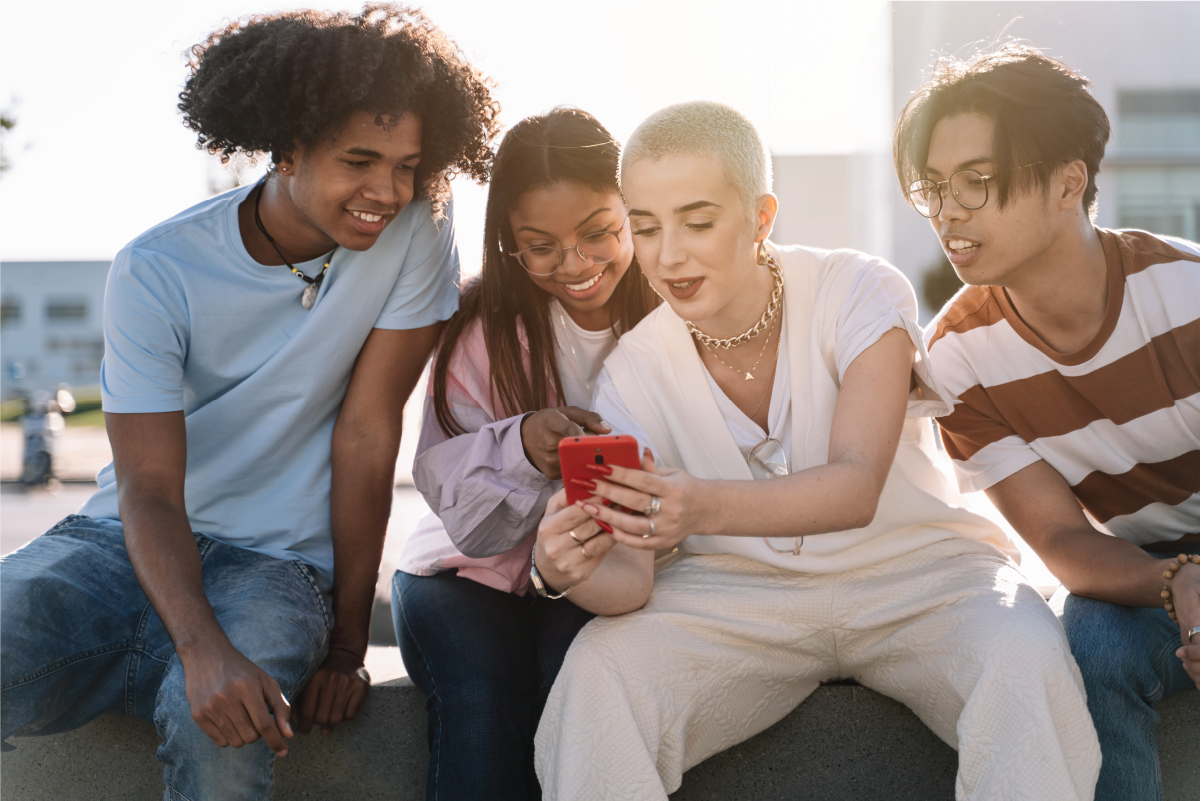
This post is the next in our series, Supporting Teen Mental Health, which shares tools and insights that support youth-serving adults in showing up for teens in this moment of need. Click here to read the first post in the series about mindfully managing difficult emotions.
Social media use gets a bad rap, and there are certainly reasons for caution. As shared in the U.S. Surgeon General Advisory's recent report on teen mental health, in 2020, 81% of 14- to 22-year-olds said they used social media either "daily" or "almost constantly" and in some circumstances social media use has been linked to poor mental health outcomes.
These findings may be alarming to adults who care about young people and want to protect them online, but as one teen shared with us, "To a high schooler, representation on social media is a huge deal...they don't want authority stepping into their fun zone." Even though guidance and support can be helpful, adults often lead with fear and hammer on the dangers of social media without identifying the opportunities. Yes, we all can strive to be intentional in our use of social media. Adults can model that intentionality. Adults also can reframe social media as one important tool young people and adults can use to support things that matter to them.
ACTIVE SOCIAL MEDIA USE VS. PASSIVE SOCIAL MEDIA USE
How well social media connects or isolates us depends partly on the behaviors we embody while using it. The Advisory reports on an important distinction between passive and active social media use, highlighting how healthier the latter is.
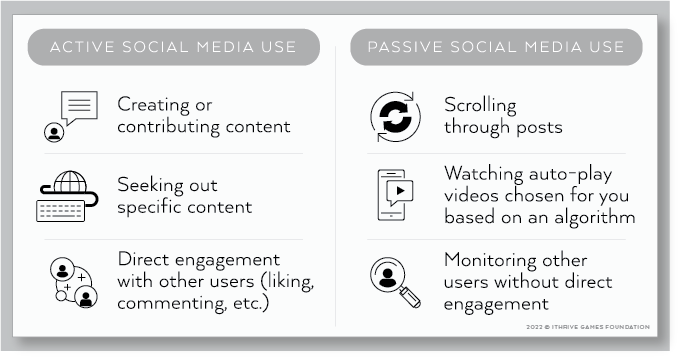
An active social media user uses its platforms to enrich and simulate real life. They use social media to connect, share and talk to the people they know, and actively engage with communities that offer new perspectives or that share their interests and hobbies. On the other hand, a passive user does not directly engage with others on social media platforms. Instead of actively interacting with others, they wait for content to come to them. Research shows that passive use of social media induces feelings of isolation, sadness, and depression often spurred by viewing the lives of others. If we're all aware of the behaviors that support more positive and healthier experiences on social media, we know which usage patterns to strive for whenever we're online.
HOW TO USE SOCIAL MEDIA ACTIVELY AND MAKE THE MOST OF IT
We spoke to a few of the teens we've worked with to co-create learning experiences for high school classrooms and asked about how they engage with and on social media. Their answers point to how social media, when reframed as a relevant tool for teens and when used actively, supports self-regulation and social connection along with the exploration of self, emotions, thoughts, and interests. Whether you're a teen or an adult, these five tips can help you make the most of social media use so you can post and peruse with purpose:

1. SET YOUR INTENTION.
Why are you going on this social media platform right now? What are you looking for or hoping to feel? If it's simply to escape and avoid anything heavy for a little while, that's valid! Since these platforms are designed to pull you in and keep you on as long as possible, just notice without judgment when your use is drifting from your initial intention and take a pause to bring yourself back to it.
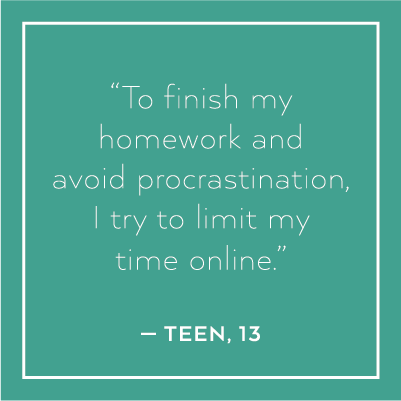
2. CONSIDER SOCIAL MEDIA USE AS ONE PART OF A HEALTHY MENTAL DIET.
Social media use can promote connection and contribute to mental and emotional health when used mindfully and in balance with other healthy behaviors like sleeping enough (7-9 hours for adults, 8-10 for teens), keeping your body moving, spending time with others in person, taking time to reflect on who you are and what you want, and more. Over a few days or weeks, notice what portion of your mental health "plate" social media takes up, and look for opportunities to continue to fine-tune your best balance.

3. CREATE AND EXPRESS.
Especially for teens, social media is a great place to make content and express the many aspects of a dynamic personal identity. Try your hand at making up a dance, sharing artwork, or narrating an experience that reflects who you are and what you care about. You can also make it a point to actively appreciate content you love that others create, like by adding your comments and reactions. This can be a good first step if you typically spend your time online consuming others' content without deeper engagement.
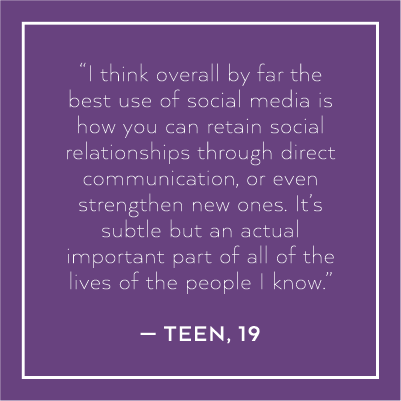
4. FIND YOUR PEOPLE.
Social media platforms connect us to the wider world. What a fantastic opportunity to both expand our perspectives and find others who help us to feel a sense of belonging. For teens, especially those struggling to find acceptance at home or in school for various reasons, reaching out for support on social media can be a lifeline. Search for (or create!) a group around a special interest. Request to join if the group is private, and then introduce yourself to get a conversation and connection started.
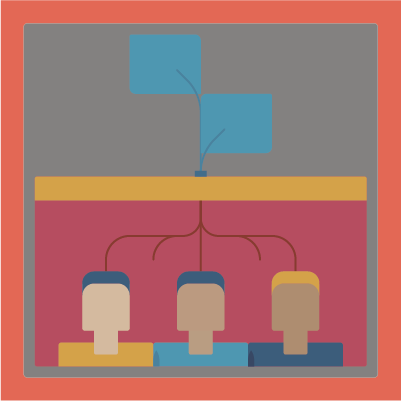
5. MAKE A DIFFERENCE.
Now more than ever, social media is a platform that can ignite support for causes that better the world. Teens are so often at the forefront of changes like these. To really level-up your social media use, start an online petition or relief fund and share it with your friends and followers, or look for opportunities others have initiated where you can lend your voice, time, and talents.
Social media offers meaningful opportunities and can be a sacred "fun zone" for teens. If you're an adult who cares about teens, reinforce those meaningful opportunities by highlighting them when you notice them. If you're a teen, consider sharing with the adults in your life about what social media allows you to do for your mental health and what intentional use looks and feels like to you.
At iThrive, we are building engaging learning experiences where teens can experiment without judgment with different ways to express themselves and connect empathically with others. To stay up-to-date on our offerings and the latest posts in the Supporting Teen Mental Health series, sign up for our mailing list today.
Teen Mental Health: Use This 2-Min. Exercise When Difficult Emotions Surface
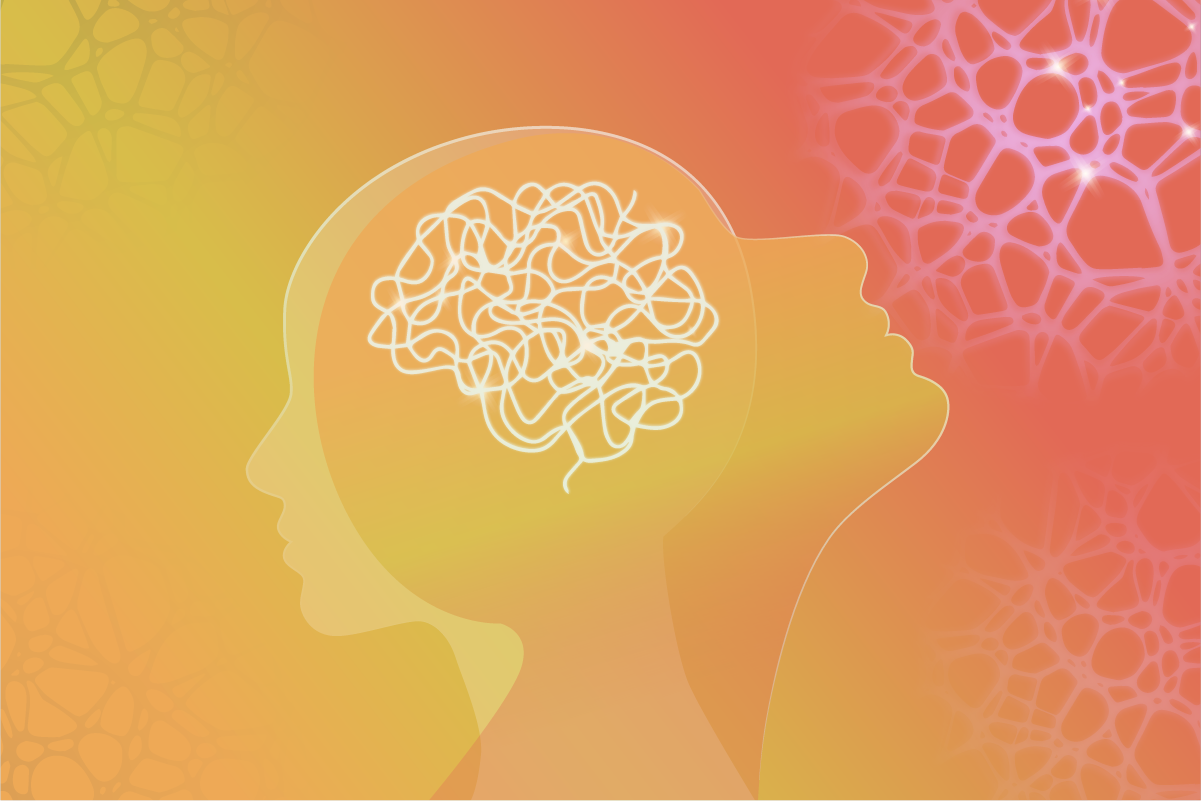
Unprecedented times come with unprecedented challenges, and the ones that today's young people face are tough to navigate. The data shared in the U.S. Surgeon General's Advisory on Protecting Youth Mental Health confirms this. National surveys show that one in three high school students experiences persistent sadness or hopelessness. The world-shifting consequences of an ongoing pandemic coupled with the big emotions that accompany adolescence make our collective need to support teen mental health and well-being both urgent and necessary.
INTRODUCING THE SUPPORTING TEEN MENTAL HEALTH SERIES
The prevalence of mental health challenges amongst youth requires an all-of-society effort to facilitate the individual and structural changes needed to support and protect teen thriving. Over the next few months, we'll be sharing vetted tools and actionable insights as part of a new five-post blog post series titled, Supporting Teen Mental Health. Mapping back to the U.S. Surgeon General's recommendations, each post will feature helpful tips and resources designed to support all youth-serving adults in showing up for teens in this moment of need.
To kick off the Supporting Teen Mental Health series, here's a quick and effective exercise that can be used and shared with teens (and adults!) to support them in getting grounded when big emotions surface.
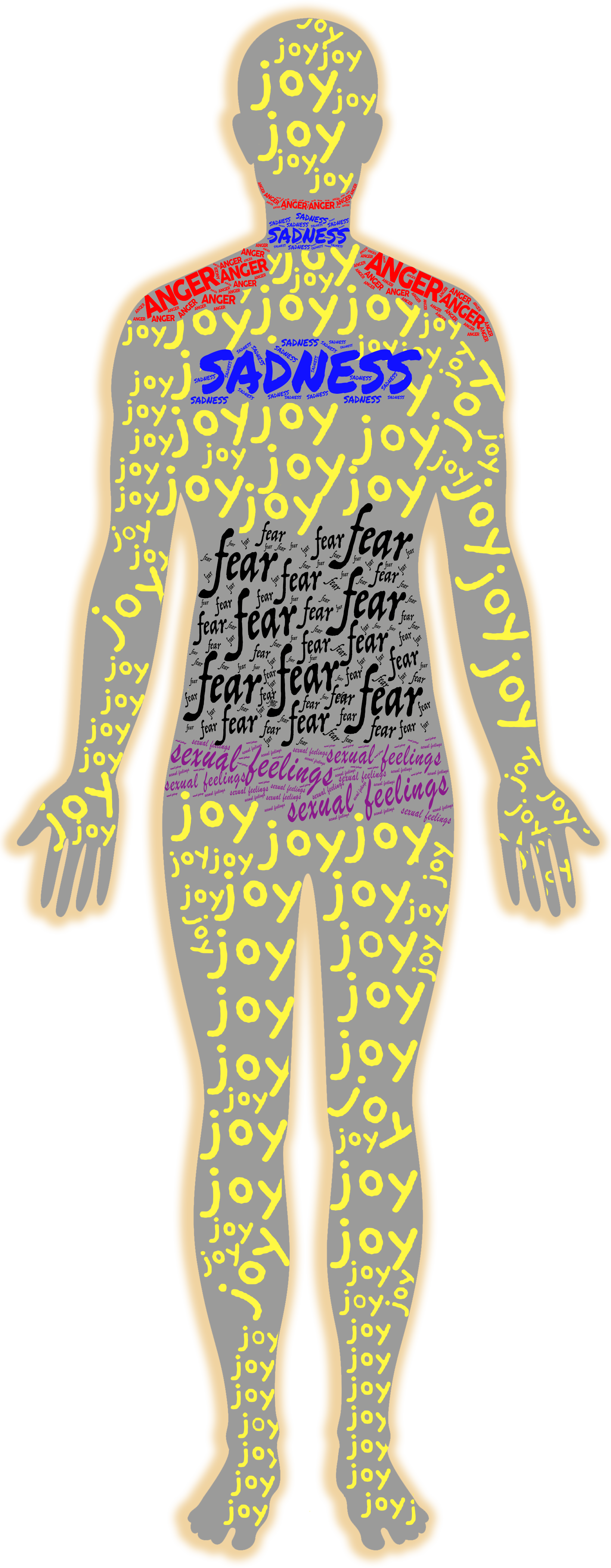 PAUSE-BREATHE-NAME: A 2-MINUTE GROUNDING EXERCISE
PAUSE-BREATHE-NAME: A 2-MINUTE GROUNDING EXERCISE
Whether you're a teen or an adult, chances are you've had moments, shifts, and shocks in life that have brought up strong emotions. In those moments, it can be difficult to regulate those feelings. Pause-Breathe-Name is a quick exercise that can help us manage:
Pause: Start by noticing that a strong feeling has shown up for you and allowing yourself to take a pause before your next word or action.
Breathe: Next, take a couple of breaths. Allow your exhale to be longer than your inhale. This will help to calm your nervous system. As you breathe, try to notice where the strong feeling is showing up in your body. We often feel sadness in our throat, fear in our belly, and anger in our upper back, neck, and jaw. Joy tends to show up all over.
Name: Finally, work on naming the feeling in your head or out loud before returning to what you were doing. The act of naming emotions, especially the more unpleasant ones, actually helps lessen the intensity of those feelings.
This exercise is part of the many social and emotional learning activities in our iThrive Sim role-playing simulation experiences. Students have shared that this exercise has helped them acknowledge moments of discomfort, frustration, and uneasiness they felt while playing as their character, and prepared them to unpack those moments with their classmates. These skills are needed when we have difficult conversations, and practicing these skills helps to strengthen them.
You can use the Pause-Breathe-Name exercise to ground yourself in times of stress and to name the feelings showing up in your body in those moments. What are some other exercises and practices you turn to to get grounded in times of stress? Share with us at contact@ithrivegames.org and stay updated on the latest in the Supporting Teen Mental Health blog series by joining our mailing list today.
Mental Health Awareness Month
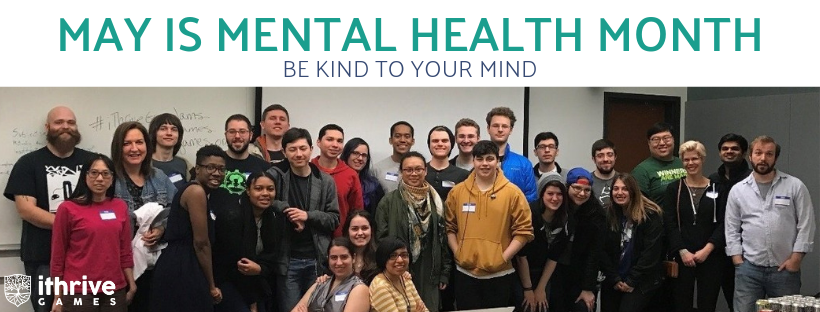
Mental Health Awareness Month takes place each year during the month of May. Established in 1949, Mental Health Awareness Month was created to increase awareness around mental health and mental wellness. The National Alliance on Mental Illness (NAMI) reports that 60 million Americans - approximately one in five - experience mental illness in a given year and 50% of all mental illness starts by age 14.
The rate of teens who are experiencing mental health difficulties is rising. We at iThrive Games take these rising numbers very seriously and that is why iThrive offers mental health initiatives that are designed to build social and emotional skills, as well as reduce the barriers to treatment for teens.
Throughout the month of May, we have been highlighting our resources that support strengths-based mental health outcomes through gameplay and more.

Photo from the National Alliance on Mental Illness
What We Do
iThrive's mental health initiatives reveal the power of games for use in therapeutic settings and create supportive experiences for teens to explore identity, wellness, and meaning.
We offer Clinician Guides which are resources for mental health providers who use or want to use games therapeutically. iThrive understands that it is impossible to be knowledgeable about every game a teen client is playing but we also believe that savvy clinicians understand the importance of using clients' passion to pursue treatment goals.
That is why we created these one-page information sheets about popular commercial games that can inform therapeutic discussion and, more importantly, demonstrate genuine interest and support for teen clients.
Our Clinician Guides were created by Kelli Dunlap, PsyD, in partnership with mental health professionals who are familiar with the games and have used them in therapeutic settings. Each guide is reviewed by a licensed mental health professional.
iThrive's resources for educators and parents alike showcase how to use games to engage the whole teen. From curricular resources to an article series and our curated games catalog, our website houses a wealth of information that highlights compelling games that feature mechanics, narratives, and other elements identified by players, professional game developers, game scholars, educators, and scientists that are supportive of habits for thriving such as empathy, curiosity, growth mindset, and kindness. We also offer a Mental Health Design Kit which serves as an informational resource to thoughtful design around mental illness.
The goal of iThrive is to be an ally to teens, including those who are struggling with mental health conditions. We work to create a space and support system to prepare them with the social and emotional skills they need in order to cope with challenging and unfair environments.

Why This is Important
Everyone should have the opportunity to thrive and live their best life. Stigmas surrounding mental health conditions have no room for existence because help is available and there is nothing wrong with seeking it.
HealthyChildren.org says that "9 in 10 teens who take their own lives met criteria for a diagnosis of psychiatric or mental health condition or disorder—more than half of them with a mood disorder such as depression or anxiety." You can find additional information on the prevalence and impact of mental health conditions here.
Change is Needed
Communication is key to making any real change. All people need to feel safe and accepted so that they can open up and let their voice be heard. We want to create space for teens to have the voice, choice, and agency they need for mental wellness. By doing so, not only will they be better able to cope with the many stresses life can bring, but they will also be able to create positive impacts on their communities.
If you'd like to stay up to date with the ways iThrive is working in your community, signup for our newsletter here.
You can also follow us on Facebook and Twitter as we continue to strive to bring awareness to the importance of mental health.
Introduction to iThrive’s Clinicians Guides
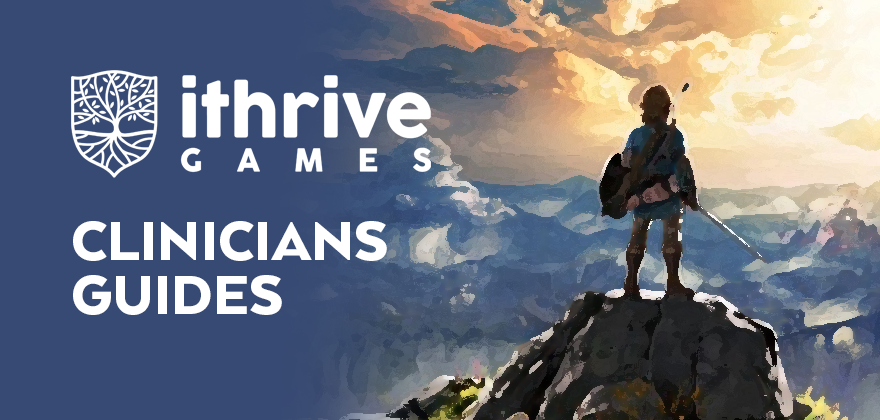
Games are a 21st-century cultural competency. Over half the U.S. population and up to 97% of U.S. teens play video games on a regular basis. Games play an important role in how teens socialize. Games foster connections between friends, offering a space for hanging out together, having fun, devising a strategy, and bonding over shared interests.
For professionals who provide mental health services, the likelihood of seeing clients for whom games matter is substantial. Because of the volume of games released each year and the speed at which players move from one game to another, awareness and understanding of contemporary and relevant games is challenging in general. This is especially true for professionals who provide therapeutic services to teens.
The iThrive Games Clinicians Guides are an educational resource for mental health professionals who understand that embracing a teen's passion for games is an opportunity to enhance the therapeutic process.
"I have found iThrive's Clinicians Guides to be useful in therapeutic practice for helping clinicians understand more about virtual worlds, the powerful and positive impact they have on us, and how to provide appropriate and culturally advantageous endeavors with their clients." - Anthony Bean, Ph.D., psychologist and author of Working with Games and Gamers in Therapy: A Clinician's Guide
Created by mental health professionals for mental health professionals, these one-page "cheat sheets" identify key components of specific video games including their themes, characters, and play styles that can be integrated into therapeutic settings. The goal of the guides is to give mental health providers basic information about a specific, popular video game and different ways to leverage a client's passion for the game in the interest of therapeutic or treatment goals.
We worked with mental health professionals to create and review each of the Clinicians Guides. They have all been field tested and refined to be helpful and practical even for those unfamiliar with the games. The games selected represent some of the most popular games available today.
"Not all games are created equal! Understanding the distinguishing features of different video games is key to understanding what role it might be playing in someone's life. iThrive's Clinicians Guides provide the keys to unlock those answers." - Rachel Kowert, Ph.D., psychologist and author of A Parent's Guide to Video Games
The guides are fundamentally grounded in Human-Centered ideology, the belief that a person grows and thrives when they feel valued, validated, connected to others, and understood. In today's media landscape, competency around games is key to providing this experience.
Each guide was designed to provide a foundation for therapeutically-minded conversations with teens about games. All guides contain a brief summary of the game, highlight events or themes in the game that align with therapeutic framing, a list of questions to spark discussion and reflect genuine interest in the person and their game of choice, and a case example of how the game or game content was used in an actual therapeutic setting. Although not every provider has the resources — time, financial, tech-savviness — to have games and game consoles in their office, there is immense clinical and therapeutic value in being able to just talk with someone about the games that are meaningful to them.
"While video games are ubiquitous, not everyone is a gamer. These guides provide succinct, useful summaries for teachers, clinicians, and caregivers to better understand the completeness of what goes on in various games. And, of course, better understanding helps with better communication with those we care about!" - Raffael Boccamazzo, PsyD, psychologist and Clinical Director of Take This
What do you think? We invite you to:
- Use our Clinicians Guides.
- Let us how they worked for you and/or if they can be improved.
- Share with us your game recommendations for our next set of guides.
Collaborate with us! Email us to find out how.
Extra Credits and Mental Health Month
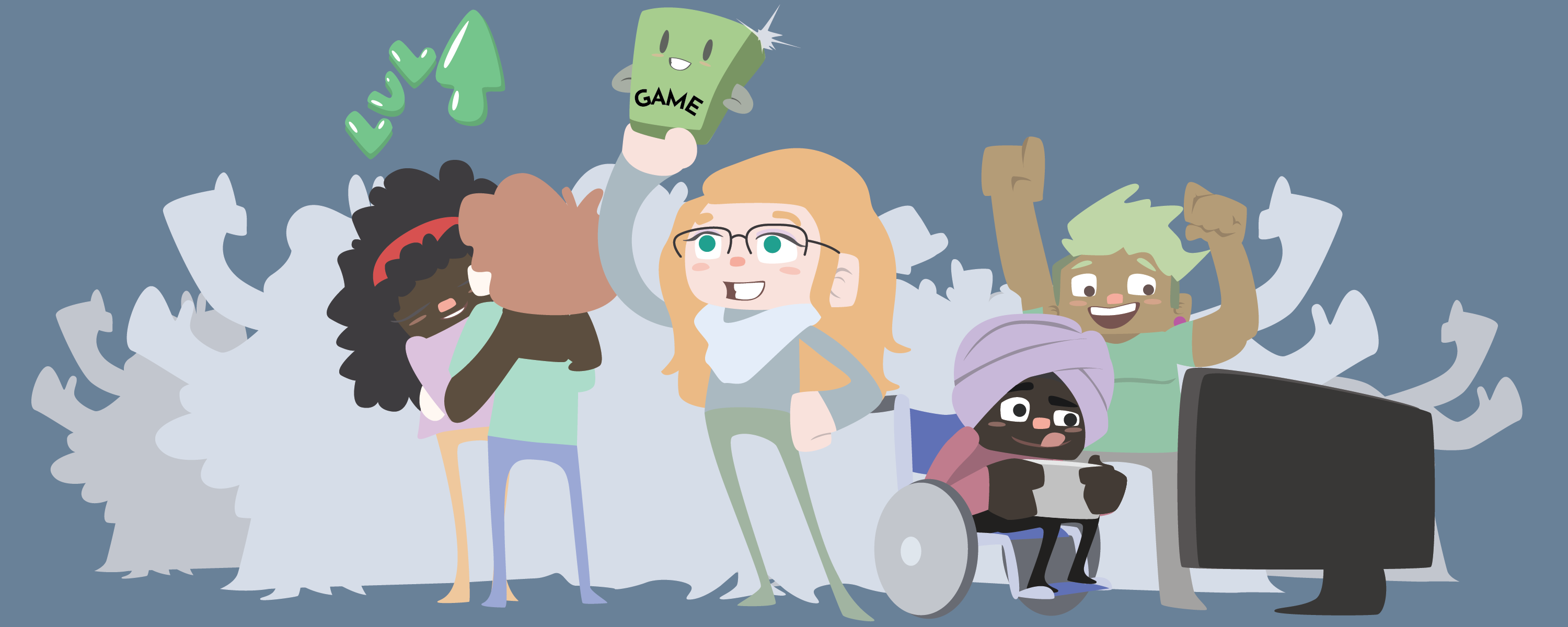
Video games frequently portray characters as having a mental illness but there's little research around those portrayals. This month, we are honored to report that Kelli Dunlap, PsyD, our director of mental health research and design, partnered with Extra Credits to deliver a quick and succinct summary of some of the problems with mental illness depictions in games. Much like Kelli's formal analysis of this topic, Representation of Mental Illness in Video Games, this episode of Extra Credits hopes to offer guidance for future game researchers and developers on how to think critically about the representation of mental illness in games.
Extra Credits is an informative, educational video series about various topics within the intersection of gaming, history, and education. According to Time Magazine,
"Over the course of ten years and hundreds of episodes, Extra Credits has explored a dizzying array of topics, from unraveling gaming's technical mysteries and exploring cultural flashpoints to making history and mythology as much fun to watch as fiction."
While Extra Credits generally covers game-centric topics, they also delve into history, education, and other subject matter. Some of the topics covered by Extra Credits in the past are:
Making Your First Game: Basics - How To Start Your Game Development
The Three Pillars of Game Writing - Plot, Character, Lore
Technical Debt - Improving the Production Pipeline
Extra Credits has turned into a viral YouTube presence with over 2 million subscribers and offering many different channels, including Extra Sci Fi, Extra History, Extra Mythology, Extra Politics, and more. Because of the great wealth of insight Extra Credits has provided to the game development community, we thought a partnership around mental health makes sense.
The episode Kelli co-authored for Extra Credits speaks specifically to the way in which mental illness is portrayed in games. Often times villains or negatively-identified characters are explicitly said to be "insane," "psycho," or "crazy." Using words like this in regards to persons with mental illness, real or fictional, perpetuates and normalizes harmful stereotypes and this kind of irresponsible representation should be addressed by more game developers. The episode lays out a summary of why this topic is important, what can be done about it, and how game developers can move forward to create more responsible depictions of mental illness in their work.
This episode was written as a part of iThrive's initiative to promote Mental Health Month. Some more projects we're highlighting this month are:
Beyond Gameplay
Beyond Gameplay is a podcast where humanity as the core mechanic is the centerpiece. Each episode is a quest to answer a core curiosity — what lives on when the game is turned off? The podcast features Kelli Dunlap, PsyD, interviewing game developers, mental health professionals, educators, and scientists about a wide array of topics. The first episode of Beyond Gameplay, Empathy in Games, will be launching later this month.
Mental Health Design Kit
Twenty-five percent of video games display mentally ill characters. However, there are no guidelines or best practices around portraying mental illness in games. iThrive's Mental Health Design Kit serves as an informational resource to thoughtful design around mental illness. Later this month we release this guide to help game developers take stronger considerations into their depictions of mental health.
Clinician Guides
Another part of our Mental Health Month initiative is our clinician guides. These serve as an educational resource for mental health professionals who use or want to use games as a vehicle for engaging teens therapeutically and on their terms.
Video Games and Suicide Prevention Blog
In this blog, Michelle Colder Carras, Ph.D., discusses how gameplay provides many ways to foster mental health and what role the gaming community can play in suicide prevention. It provides an important and necessary point of view for a growing public health problem.
Sign up for our newsletter to receive early access to these resources and more!
Video Games and Suicide Prevention

If you are experiencing a crisis or having thoughts of suicide, please contact the National Suicide Prevention Lifeline at 1-800-273-TALK (8255), the Crisis Text Line by texting HOME to 741741, or visit the nearest emergency room.
Suicide is a growing public health problem and the second leading cause of death among young people in the US and worldwide (Hedegaard & Curtin, 2018; World Health Organization, 2018). People may attempt suicide when they feel overwhelmed by problems, pain, and hopelessness but feel they lack the resources or support to cope (Verrocchio et al., 2016). Connecting people to others who can provide mental health support and assistance with coping skills helps prevent suicide (Stone et al., 2017), and video games can play an important role by fostering connections and support. Whether through in-game interactions, membership on teams or guilds of players, or interactions on communication/media platforms such as Discord and Twitch, games offer many opportunities for players to communicate and connect (Colder Carras, Rooij, et al., 2018; Kowert & Quandt, 2016). Recently, video game communities have been tackling the need for mental health support and suicide prevention for their members through a variety of innovative programs. iThrive Games is happy to be talking about our efforts in an upcoming panel called Suicide Prevention in Video Game Communities to be held April 27 at the American Association of Suicidology annual conference in Denver, Colorado.

Famous screenshot from Legend of Zelda (Nintendo, 1986), often used as a meme to encourage others to seek and utilize help.
Many different factors have been linked to suicide. According to one theory, individuals who die by suicide are driven by three factors: feeling that they are a burden to others, feeling frustrated in their efforts to make meaningful connections, and becoming numb to the pain and fear associated with the idea of dying (T. Joiner, 2005; T. E. Joiner et al., 2009). These, along with hopelessness and difficulty with solving problems, making decisions, or seeking help can drive suicide ideation and attempts (Gvion & Levi-Belz, 2018; Joiner et al., 2009). Addressing social isolation/loneliness and problems coping with life stresses can be important targets for suicide prevention programs (Stone et al., 2017). Although about half who die by suicide do not have a mental health diagnosis ("More than a mental health problem," 2018), those who have a diagnosis are more likely to feel like they don't belong (Ma, Batterham, Calear, & Han, 2019). Suicide is a particular risk for some groups such as adolescents, older adults, military veterans, the unemployed, or those with low socioeconomic status (Bryan, Jennings, Jobes, & Bradley, 2012; Nock et al., 2008; World Health Organization, 2018). Members of marginalized groups such as LGBTQI individuals, refugees and immigrants, and indigenous peoples also have higher suicide rates (Forte et al., 2018; Harlow, Bohanna, & Clough, 2014; Hottes, Bogaert, Rhodes, Brennan, & Gesink, 2016).
Preventing suicide is a challenge. Even though we know factors that are associated with more or fewer suicidal thoughts and behaviors, existing prevention programs have yet to make reduced rates of suicide worldwide. One of the most common measures in prevention is gatekeeper training-teaching individuals who are not mental health specialists how to recognize the signs of suicide risk, ask questions about suicidal thoughts and plans and manage suicidal behavior (Stone et al., 2017). Crisis intervention services such as the National Suicide Prevention Lifeline and local call or text centers provide anonymous assessment and counseling by trained individuals who often volunteer from the local community.

Twitter response to the prompt "Tell me about the happiest experience you've had either in a game or because of games? What do they add to your life?"
New approaches to suicide prevention are needed, and recent research has focused on the potential role of video games in suicide prevention. We know that video games help people connect and feel that they belong to a community (Kowert, 2016). Joining teams or guilds, or even just hanging out with people in-game helps players bond through shared activities (Steinkuehler & Williams, 2006; Williams et al., 2006). In a recent study of veterans in treatment for mental health conditions, playing games with others was found to be an important source of social interaction that helped some veterans overcome isolation or assume leadership roles (Colder Carras, Kalbarczyk, et al., 2018). Although taking a break from daily life through games or other entertainment media is a common method of recreation that can help people recharge (Oliver et al., 2015), this study found that some veterans used games to help ward off suicidal thoughts or substance cravings when other coping strategies didn't work (Colder Carras, Kalbarczyk, et al., 2018). Of course, excessive use of games can lead to other problems, so therapists should work with clients to understand the role and uses of gameplay in dealing with life challenges.
Video game groups, researchers, clinicians, and nonprofits are now seeking ways to leverage these potential benefits of video games. iThrive and academic groups such as the Games for Emotional and Mental Health Lab at Radboud University work to develop and promote games that enhance social and emotional learning, reduce anxiety, and teach problem-solving through gameplay experiences. The organization Stack Up provides a host of grassroots, game-related programs that support positive well-being through games, but is best known for its unique online suicide prevention program. STOP (the Stack Up Overwatch Program), which provides anonymous online crisis intervention services and referrals 24/7 for adult members of its Discord server.

Twitter response to the prompt "Tell me about the happiest experience you've had either in a game or because of games? What do they add to your life?"
Other organizations focus on education and messaging to reduce stigma—getting the word out about mental health problems and fostering healthy discussions about coping. The weekly Twitch broadcast PsiStream, led by a licensed mental health counselor, educates viewers about mental health problems and encourages them to ask questions about uncomfortable or challenging topics. The nonprofit organization Take This supports mental health in the game industry through initiatives such as the Ambassador program, which recognizes Twitch streamers who promote positive mental health through their streams. These emerging efforts provide exciting new opportunities to make a difference in suicide prevention and mental health support in the games industry.
Gameplay provides many ways to foster mental health, and the game community is leading the way with innovative programs. Join iThrive on April 27 as we discuss our efforts along with Stack Up and Take This at the American Association of Suicidology meeting. Stay tuned for a link to our live stream on Twitch. And remember that help is available-if you or anyone you know is affected by suicidal thoughts or behavior, contact the National Suicide Lifeline at 1-800-273-TALK (8255) or the Crisis Text Line by texting HOME to 741741.
References
Bryan, C. J., Jennings, K. W., Jobes, D. A., & Bradley, J. C. (2012). Understanding and preventing military suicide. Archives of Suicide Research, 16(2), 95-110.
Colder Carras, M., Kalbarczyk, A., Wells, K., Banks, J., Kowert, R., Gillespie, C., & Latkin, C. (2018). Connection, meaning, and distraction: A qualitative study of video game play and mental health recovery in veterans treated for mental and/or behavioral health problems. Social Science & Medicine. https://doi.org/10.1016/j.socscimed.2018.08.044
Forte, A., Trobia, F., Gualtieri, F., Lamis, D. A., Cardamone, G., Giallonardo, V., ... Pompili, M. (2018). Suicide Risk among Immigrants and Ethnic Minorities: A Literature Overview. International Journal of Environmental Research and Public Health, 15(7). https://doi.org/10.3390/ijerph15071438
Gvion, Y., & Levi-Belz, Y. (2018). Serious Suicide Attempts: Systematic Review of Psychological Risk Factors. Frontiers in Psychiatry, 9. https://doi.org/10.3389/fpsyt.2018.00056
Harlow, A. F., Bohanna, I., & Clough, A. (2014). A systematic review of evaluated suicide prevention programs targeting indigenous youth. Crisis, 35(5), 310-321. https://doi.org/10.1027/0227-5910/a000265
Hottes, T. S., Bogaert, L., Rhodes, A. E., Brennan, D. J., & Gesink, D. (2016). Lifetime Prevalence of Suicide Attempts Among Sexual Minority Adults by Study Sampling Strategies: A Systematic Review and Meta-Analysis. American Journal of Public Health, 106(5), e1-12. https://doi.org/10.2105/AJPH.2016.303088
Joiner, T. E., Van Orden, K. A., Witte, T. K., Selby, E. A., Ribeiro, J. D., Lewis, R., & Rudd, M. D. (2009). Main Predictions of the Interpersonal-Psychological Theory of Suicidal Behavior: Empirical Tests in Two Samples of Young Adults. Journal of Abnormal Psychology, 118(3), 634-646. https://doi.org/10.1037/a0016500
Kowert, R. (2016). Social outcomes: Online game play, social currency, and social ability. In R. (Ed) Kowert & T. (Ed) Quandt (Eds.), The video game debate: Unravelling the physical, social, and psychological effects of digital games. (pp. 94-115). New York, NY, US: Routledge/Taylor & Francis Group. (2015-20483-006).
Ma, J. S., Batterham, P. J., Calear, A. L., & Han, J. (2019). Suicide Risk across Latent Class Subgroups: A Test of the Generalizability of the Interpersonal Psychological Theory of Suicide. Suicide & Life-Threatening Behavior, 49(1), 137-154. https://doi.org/10.1111/sltb.12426
More than a mental health problem. (2018, November 27). Retrieved April 15, 2019, from Centers for Disease Control and Prevention website: https://www.cdc.gov/vitalsigns/suicide/index.html
Niederkrotenthaler, T., Voracek, M., Herberth, A., Till, B., Strauss, M., Etzersdorfer, E., ... Sonneck, G. (2010). Role of media reports in completed and prevented suicide: Werther v. Papageno effects. The British Journal of Psychiatry: The Journal of Mental Science, 197(3), 234-243. https://doi.org/10.1192/bjp.bp.109.074633
Nock, M. K., Borges, G., Bromet, E. J., Alonso, J., Angermeyer, M., Beautrais, A., ... Williams, D. (2008). Cross-national prevalence and risk factors for suicidal ideation, plans and attempts. The British Journal of Psychiatry: The Journal of Mental Science, 192(2), 98-105. https://doi.org/10.1192/bjp.bp.107.040113
Oliver, M. B., Bowman, N. D., Woolley, J. K., Rogers, R., Sherrick, B. I., & Chung, M.-Y. (2015). Video Games as Meaningful Entertainment Experiences. Psychology of Popular Media Culture, 5(4), 390-405. http://dx.doi.org/10.1037/ppm0000066
Steinkuehler, C. A., & Williams, D. (2006). Where Everybody Knows Your (Screen) Name: Online Games as "Third Places." Journal of Computer-Mediated Communication, 11(4), 885-909. https://doi.org/10.1111/j.1083-6101.2006.00300.x
Stone, D., Holland, K., Bartholow, B., Crosby, A., Davis, S., & Wilkins, N. (2017). Preventing Suicide: A Technical Package of Policies, Programs, and Practices. Atlanta, GA: National Center for Injury Prevention and Control, Centers for Disease Control and Prevention.
Williams, D., Ducheneaut, N., Xiong, L., Zhang, Y., Yee, N., & Nickell, E. (2006). From Tree House to Barracks: The Social Life of Guilds in World of Warcraft. Games and Culture: A Journal of Interactive Media, 1(4), 338-361. https://doi.org/10.1177/1555412006292616
World Health Organization. (2014). Preventing suicide: a global imperative. Retrieved from https://apps.who.int/iris/bitstream/handle/10665/131056/9789241564878_eng.pdf?sequence=8
World Health Organization. (2018). National suicide prevention strategies: progress, examples and indicators. Retrieved from https://apps.who.int/iris/bitstream/handle/10665/279765/9789241515016-eng.pdf?ua=1
Exploring the Intersection of Video Games and Mental Health
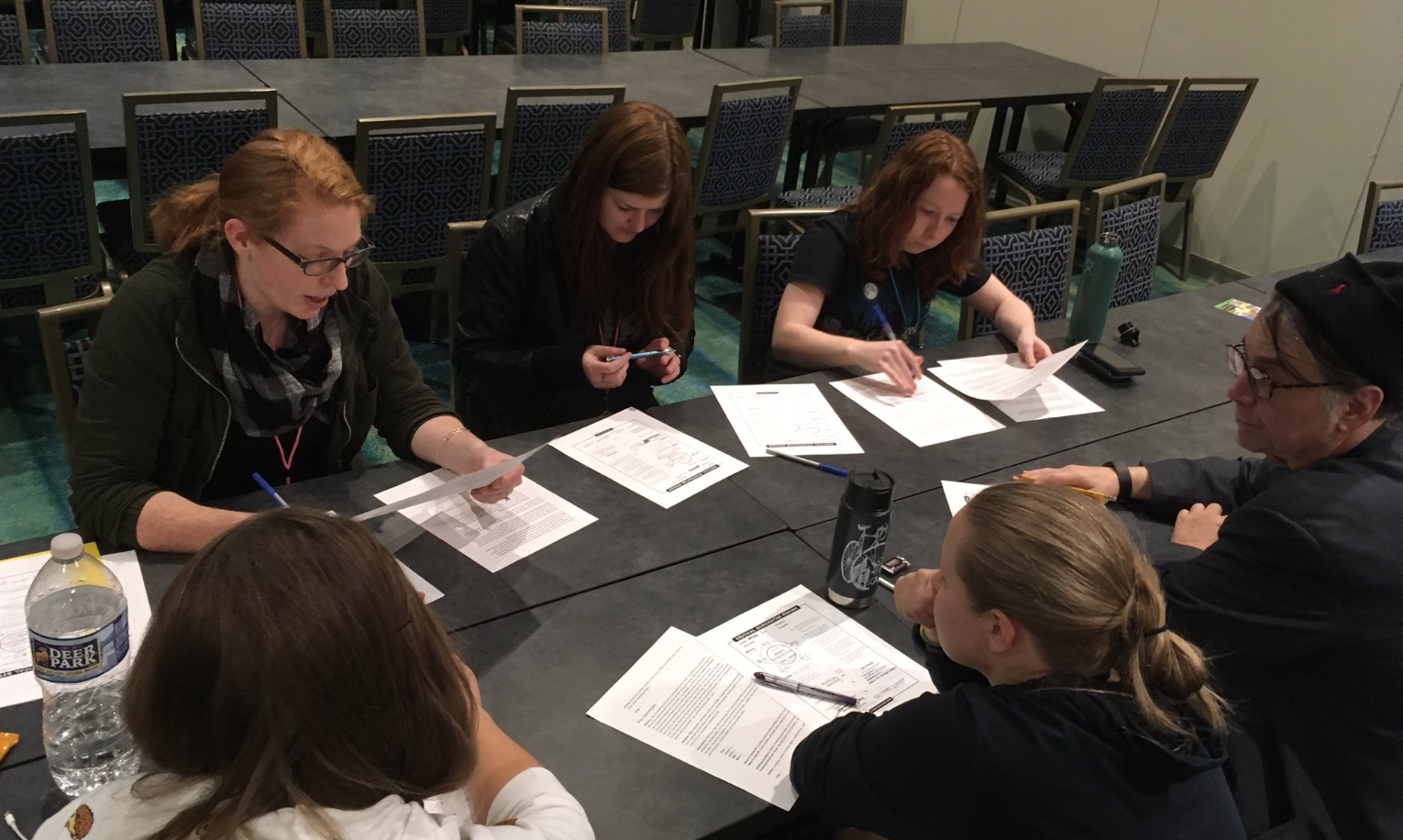
MAGFest 2019 - A Compilation of Panels, Playtesting, and so much more!
Kelli Dunlap, PsyD, director of Mental Health Research and Design at iThrive Games, playing our Critical Strengths Engine (CSE) as she helps a new playtester facilitate the game for the rest of the group.
With over 20,000 people in attendance, iThrive Games was beyond excited and thankful for the opportunity to be a part of MAGFest for the third year in a row. This annual event celebrates music and games while attracting attendees, speakers, musicians, and cosplayers from all over the world. MAGFest enables us to be surrounded by like-minded individuals who believe in promoting prosocial outcomes.
Showcasing iThrive's Critical Strengths Engine
MAGFest Indie Tabletop Showcase featured iThrive's Critical Strengths Engine (CSE), a pen and paper role-playing game ruleset for exploring and supporting social and emotional skill development.
In 2017, Ian McDonald posed this question to us at one of our game jams,
"What if there were a system for tabletop role-playing games (TTRPGs) based around social and emotional attributes like emotional integrity, instead of strength and dexterity?"
To say this piqued our curiosity is an understatement. It launched the idea for the CSE and we've been working on it ever since!
We designed the CSE to be accessible and enjoyable for all players, and were especially mindful in our development that it meet the needs of mental health professionals working with teens.
At the MAGFest panel, The Making of a Therapeutic RPG, iThrive's Kelli Dunlap, PsyD, director of mental health research and design, and Sean Weiland, producer, talked about the collaborative design process for the CSE and shared lessons learned in development and during playtesting. Also on the panel were our CSE collaborators, mental health provider and executive director of the Bodhana Group, Jack Berkenstock, and game designer, Max Raabe. We shared with the audience the unique rewards and challenges of designing with a truly interdisciplinary group, and how we strove to balance fun, a strengths-based focus, engaging stories, and therapeutic relevance.
Jack Berkenstock, mental health provider and executive director of the Bodhana Group, playtesting with a group of eager participants.
During development, our design team at iThrive went through 10 versions of the CSE character sheet. This game structurally lets players bring characters to life by engaging with their strengths and deficits via the "Whys" or circle of character motivation. Therapy often necessitates interacting with difficult issues. We consciously observed and allowed for the CSE to be an analogue where players can use characters to engage with issues that are difficult for them.
Following the panel discussion, 20 people joined us to playtest the CSE. Not only did this playtest extend past midnight, but it was also the largest concurrent playtest of the CSE to date! Playtesters thoroughly enjoyed taking part in the CSE playtest and it was delightful to watch both teams work together within the system of the CSE to solve problems and overcome obstacles that were thrown in their way. Some of the feedback we received from participants included the following,
"Positive! Refreshing! Great to think of solving solutions with emotional strengths rather than physical ones."
"I had a lot of fun! It was neat to focus on motivation."
"Very positive, lots of fun. Far more [than] we would have in another system with no combat. I liked how this focuses on other aspects of traveling/adventuring."
The CSE officially launches this Fall and includes four unique adventures: an official Pugmire story by Eddy Webb; Alteris, a contemporary science fantasy story by Toiya Finley; Dust, a post-apocalyptic survival game by James Portnow; and a fourth untitled story by Bodhanna Group founder, Jack Berkenstock.
Max Raabe, game designer, leading a playtest just after the panel on creating a therapeutic RPG.
Toward A New Vision of Mental Health Representation in Games
Kelli Dunlap spoke on a panel with Tanya DePass, and its organizer Meg Eden on the Mental Health Representation in Games. With standing room only attendance, this panel discussed important issues surrounding the representation, diversity, and accessibility of mental health in games. In addition to sharing their favorite examples of the representation of mental health in games, and tropes and ideas to be avoided, panelists expressed their hopes for what mental health representation could look like in future games.
Tanya said,
"I'd like to see people and characters have mental health as just a matter of course for their character and not have it be the be-all end-all. If a character needs meds or something like that just like everyday life for those that take medication it's not big deal, it's not like 'oh woe is me I have to take meds everyday to regulate my brain, therefore, I'm a garbage human' that a lot of us fall into.... This is something that is part of me and move on with it."
Kelli responded with,
"I would love for there to never be another horror game that uses an asylum ever... We see asylums or mental health institutions or psychiatric hospitals as a shorthand we use in media for 'Be afraid. Be very afraid. Bad things are going to happen.' Has anybody ever played a video game where you woke up in an insane asylum and something good happened to you immediately after? No. The trope is dead. Kill it."
The panelists also answered questions about respectful and ethical ways of dealing with difficult mental health topics within the game design process,
"Give players the chance to opt out of something. You don't know anyone's experience when you're programming a game or what's happening... Things like warnings or give me the chance to opt out or fade to black or something like that because I was not ready to deal with that scene at all." - Tanya DePass
"Games are such a creative medium that you can [do that] in creative ways that can actually benefit the design of the game. Allowing for those options can actually branch into a unique gameplay experience. It doesn't have to limit you." - Meg Eden
After the panel, one of the attendees shared his appreciation and excitement with Kelli saying, "I didn't think a game about ADHD is possible, but after your panel, I think it is and I'm excited to get started."
Keep The Conversation Flowing
At MAGFest, the fun never ceases and the conversations are always flowing. We are so grateful for the opportunity to meet with more people who aim to work to benefit teens at the intersection of game development, education, and mental health. We especially appreciated being part of the Music and Games Education Symposium (MAGES), of MAGFest, where we presented on topics related to the personal and social impact of mental health representation in games, strategies around self-care and confronting impostor syndrome, and designing for cooperation. If these topics interest you and you want to keep up-to-date with all of the happenings and projects here at iThrive, please sign up for our newsletter.
Game designer Max Raabe and Sean Weiland producer at iThrive Games (top left), the tabletop role-playing game (TTRPG) panel (top center), Kelli Dunlap, PsyD, director of Mental Health Research and Design at iThrive (top right), Jack Berkenstock executive director of the Bodhana Group, Max Raabe game designer, Sean, and Kelli (Bottom)
Grief and Job Loss: Tips for Coping with the Social and Emotional Impact of Layoffs

Kelli Dunlap is the director of mental health research and design at iThrive Games. She holds a doctorate in clinical psychology and directs iThrive's mental health and game development initiatives.
On Tuesday, February 12, games publisher Activision stated it would be laying off 8% of its workforce - about 800 people - despite record profits in 2018. Mass layoffs in the games industry are not uncommon, nor are exploitative working conditions (i.e., crunch) and job insecurity. In response to recent events similar to the Activision layoffs, there's been a call to unionize the games industry and confront current common practices in the games industry such as crunch and "feeding game developers to the machine." Addressing the current work culture is critical to the future health of the industry and its workforce, but large systemic changes take time. So what's a person to do in the meantime?
Activision Blizzard cuts hundreds of jobs despite "record-setting" revenues: https://t.co/J07hoNhWj5 pic.twitter.com/jexBaNiQ1E
— Polygon (@Polygon) February 12, 2019
After the layoffs were announced, there was ー and continues to be ー an outpouring of support over social media offering condolences, commiseration, and job openings. Some of those directly impacted by the layoff took to social media to share their grief:
Today was my last day at Blizzard Entertainment. I knew that layoffs are commonplace in the video game industry, but I somehow always thought that if I could work really hard, get the right education, and be an exceptional employee that they'd never happen to me. I was wrong.
— Jennifer Mallett (@Jen_Mallett) February 13, 2019
Job Loss and Mental Health
Grief is the body's reaction to loss. Any loss that disrupts a person's sense of self-worth or the stability of their livelihood can be grieved. Job loss is no exception. Decades of research has shown that loss of employment, especially when it is unexpected, can have a psychological impact similar to when a loved one dies.
Losing a job can set off a cascade of additional losses, some obvious like loss of income, health insurance, and financial security, and some less obvious like loss of social status,
For every time in my life that I've had a pit in my stomach, I still cannot begin to imagine the grief of those affected by the Activision Blizzard layoffs today. It's truly terrifying, and I wish them the absolute best in this trying time.
— Brian Turner (@BT_HawkGuy) February 13, 2019
For Those in Grief
For those grieving the loss of their jobs, their security, their livelihood, it's critical to remember that grief is not about passing through set stages from denial to acceptance - everyone's path through grief is unique and often complicated. It is absolutely okay to not feel okay, to feel your feelings, and to not instantly spring back as though nothing happened. Searching for a job can be just as distress-inducing as losing a job, so take the time to take care of yourself. Small things like listening to your favorite song, eating a comforting meal, connecting with friends, snuggling a pet, can buoy you while you're riding waves of emotions.
Grief extends beyond emotions and can impact physical, social, and cognitive abilities. People in grief may experience physical symptoms such as difficulty sleeping, fatigue, digestive problems, social symptoms like feeling isolated or withdrawing from others, and cognitive symptoms like difficulty concentrating and self-blame.
If you're feeling overwhelmed, reach out to someone you feel close to that will listen and not jump to "fixing" the situation. Setting up boundaries for the conversation can help you get your needs met and make the best use of your support. For example, "Hey, I'm having a tough time. Can we talk?" invites a back-and-forth conversation whereas "Hey, I'm having a tough time and need to vent. Not looking for answers, just a supportive ear" clearly conveys a desire to be heard and validated without judgment or troubleshooting.
If you feel you need more support than you currently have, please reach out to a mental health professional. Many providers offer sliding scale services, meaning they can adjust their rates to fit your budget, and most are willing to work out accommodations for those with financial constraints. Additional resources can be found via Take This' mental health resources page.
Do
- Feel your feelings, even the unpleasant ones.
- Seek support from those who will listen without judgment or trying to fix things.
- Seek support and connection with others who have been laid off as they can most closely understand what you're going through and make you feel less alone.
- Take care of your whole self, both mind, and body.
- As best you can, ask for what you need as specifically as you can.
Don't
- Let anyone tell you how to feel.
- Listen to anyone who tells you-you shouldn't be grieving or how to feel.
- Bottle up or suppress your emotions.
- Expect the grief to go away overnight or follow an orderly or linear pattern toward recovery.
How we want grief to work verse how grief actually works. pic.twitter.com/CWNhgvex8M
— Caleb Wilde (@CalebWilde) May 9, 2014
For Friends of Those in Grief
Feeling
Like experiencing the death of a loved one, job loss often evokes a variety of unpleasant thoughts and intense emotions such as anger, sadness, hopelessness, helplessness, and bitterness. Each person experiences and processes their own thoughts and emotions in their own time. If someone is "in their feelings," the best thing you can do is be supportive, listen, validate their feelings, and be present with them.
When people we care about are in distress, we experience an empathetic echo of that distress. It's normal to want to push uncomfortable feelings away. We may try to distance ourselves from those emotions by saying things like "don't worry, everything will work out," "everything happens for a reason," or "that job sucked anyway." These kinds of platitudes, however, minimize and invalidate a person's experience even though their reaction is appropriate and understandable given the circumstances.
Do
- Acknowledge the pain, sadness, and other unpleasant thoughts and feelings.
- Be present.
- Listen.
- Validate their thoughts and feelings.
- Provide support that they find comforting (i.e., hugging those who are comforted by touch, making dinner for those who are comforted by familiar friends and foods, sharing words of affirmation for those who are comforted by verbal support).
Don't
- Point out a silver lining.
- Minimize or invalidate the emotions.
- Convey a need for the person to "move on", "buck up" or "get over it."
- Make it about you (i.e., I know what it feels like...).
Fixing
Research suggests that the pain you feel from a social loss, like the loss of job and the daily relationships you have with valued co-workers, activates the same pain pathways as having a physical injury. In other words, your brain processes the pain of job loss the same way it processes the pain of a broken limb. This is why grief can feel like being punched in the gut or like your heart literally aches. When we see a friend in distress, we often jump to problem-solving or "fixing" the issue. This is a natural response - when someone we care about is in distress, we want to make them not be distressed because we care about them. However, offering solutions before working through the salient emotions is like trying to put a cast on a broken limb before setting it. It's the equivalent of applying the right kind of help at the wrong time.
When a person is ready to start working through their grief it means they are taking steps toward managing and addressing the emotional and psychological symptoms rather than solely feeling them. This is where linking to job openings, leveraging connections, and rallying resources become a helpful and actionable kind of support. Keep in mind that each person will arrive at this point at a different time. For some, it's a logical next step. For others, getting to this point can take time.
Do
- Recognize that the pain and unpleasant emotions are still there, albeit less intense, and will be for some time.
- Check in about what kinds of support would be helpful and provide specific tasks you can take on (i.e., setting up a meeting over coffee, sharing job postings, reviewing their resume etc.). This allows the griever to simply say "yes" or "no" rather than think up a task and then ask for help.
- Continue to check up and check in over time. People need support immediately after the incident as well as later on during equally stressful phases of unemployment like job searching, interviews, and starting a new position.
Don't
- View your friend as a thing to be fixed.
- Be put off if your friend declines your help or doesn't act on your suggestions. (It's not about you!)
- Ask "how's the job search going?" every time you see your friend; if something has come up, they'll let you know.
If you are worried that you or someone you care about is in distress or in need of crisis resources, you can call the National Suicide Prevention Hotline at 1-800-273-8255 or message the Crisis Text Line by texting 741741. In case of emergency, call 911.
Losing a job sucks and everyone will process, cope, and move forward in their own way, in their own time. If you're the type to see job loss not as a setback but a set-up for a new adventure, that's great. Taking time to work through your emotions, to feel sad/angry/bereft/or any other feeling you may have is also a legitimate strategy. Unpleasant emotions like grief are a way our minds alert us to danger or injustice and a flag for others that we need support. For those in the position to provide support, understand that for some moving from one job to the next is a minor inconvenience while for others it can literally be the difference between food on the table or going hungry; of affording life-preserving medication or going without. Adjust the support you give accordingly. For additional mental health resources, check out Take This' mental health resources page.
As always, take care of and be kind to yourself.
Please note: This post was written prior to the layoffs at Electronic Arts and ArenaNet. If you need assistance, please reach out to the resources shared in this article or comment below with any additional resources you know of.
UNESCO MGIEP TECH
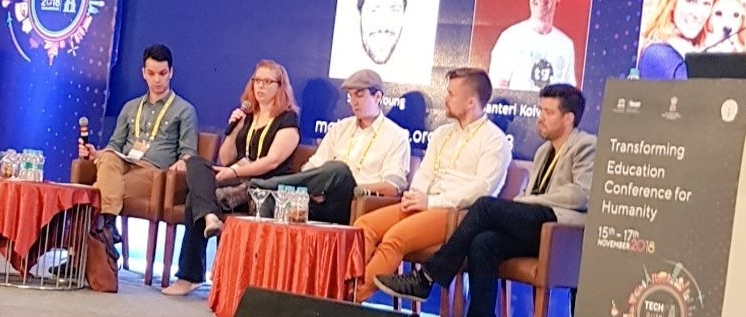
The pre-conference festivities for this year's UNESCO MGIEP Transforming Education Conference for Humanity (TECH 2018) kicked off with an outdoor, beach-side presentation on neuroscience and social and emotional learning and ended with an hour-long performance by a Dehli-based rock band The Local Train. It was an unusual and unexpected opening night, and just one of many unique and memorable moments from my trip to Visakhapatnam, India.
I'd been invited to the conference as a Catalytic Speaker for keynote panels on games and social emotional learning as well as games and mental health. The topic of the first catalytic session focused on the potential for social and emotional learning be taught by digital games. I had the honor of sharing the stage with MGIEP neuroscientist Nandini Chatterjee Singh, co-founder and CEO of Classcraft Shawn Young, assistant professor of technology, innovation and pedagogy Matt Farber, and president of Games for Change Susanna Pollack.
Pre-talk prep.
The second keynote panel addressed questions and concerns surrounding the World Health Organization's proposal to include Gaming Disorder as a diagnosis in the upcoming edition of the ICD-11. I again had the pleasure of sharing the stage with Shawn Young as well as game designer François Boucher-Genesse, CEO and co-founder of TeacherGaming Santeri Koivisto, and the panel was moderated by Affordance Studio co-founder Avery Rueb. [Video of the panel here].
And last but not least, I was delighted to co-present with Matthew Farber on boosting teen resilience through commercial video games in the classroom. We highlighted work that Matt, fellow teacher Paul Darvasi, and iThrive have been developing around using What Remains of Edith Finch to teach and explore social and emotional skills. Fostering understanding that games not designed for educational purposes can still hold educational value was a key aspect of this presentation.
The conference ended with the Vizag Declaration on Guidelines for Digital Learning, a call to establish standards for digital learning resources that best suit the educational needs of
A Canadian Game Jam On Mental Health and Teens? Mais Oui!
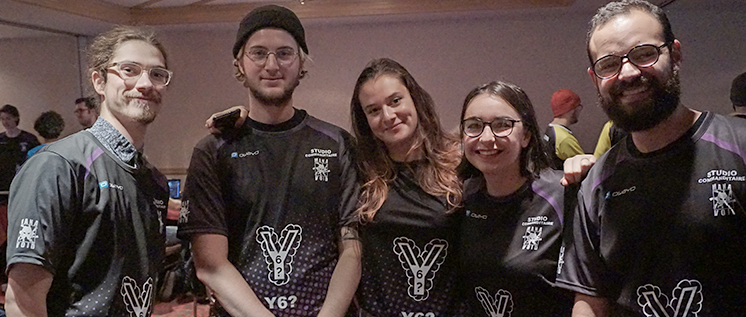
The first weekend of October, iThrive staff made their way to Montréal, Canada to co-host the JamNATION game jam. The jam was the perfect opportunity to test two shiny new Design Kits we developed with expert devs and scholars at this fall's iThrive Design Hive: "Designing for Teens" and "Games and Mental Health." We were eager to debut our design guidelines related to teens and mental health at this unique jam, and our jammers responded with equal enthusiasm!
iThrive Design Kits are best-practices guides that support developers of all experience levels in designing games that promote positive habits to help players-and especially teens-thrive. The ultimate goal of the Kits is to spur the production of compelling and meaningful games: those that perfectly combine fun and innovation with opportunities for players to build critical social and emotional skills. Game jams are where we rigorously field test these Kits to determine if they "work": are they useful and engaging? Are they accessible to devs of many backgrounds and experience levels? Do they produce relevant, innovative prototypes?
JamNATION is a game jam league, kind of like a corporate softball league. Different teams pay membership dues to compete, and teams are often sponsored by large studios such as Ubisoft. They have custom numbered jerseys and everything! There are 6-8 jams during a regular season, and the teams compete for the right to earn a spot at the Season Finale, which is a large, more luxurious jam in the spring with high-end catered food, lots of swag and prizes, comfy sofas, and a masseuse. The jam we co-hosted was the first of JamNATION's regular competitive season, and 85 jammers participated to produce 14 games!

A group of jam participants
Devs designed for themes of mental health and teens, and to make it more challenging, we introduced an additional design constraint: make games with no text or language in them. The jammers were a multilingual audience so we wanted to inspire games that would be accessible to all participants, regardless of their language abilities, and it's also in line with our focus on supporting games that are accessible to the widest range of players possible. We work to build this "Universal Design" into everything we do.
We found much more in Canada to compliment than the poutine. Our thoughtful and dedicated jammers included a couple of teens, which is not typical for a JamNATION jam and certainly enriched our conversations about designing for teens! The winning game was "Breathe," which is fully playable in 3-5 minutes. In it, you play as a teen who needs to balance an ever-increasing number of tasks — pushing buttons and pulling levers and filling meters — and who may eventually be overwhelmed and need to be reminded to "just breathe." This was a great representation of the developmental changes going on for teens, who suddenly have much more adult-like responsibilities and roles to fulfill even as their brains are still learning to cope with stress and other potentially overwhelming emotions.

A developer works on background art for a game.
Other games included a dancing gecko who would change colors to fit in with other groups of geckos (a nod to teens' competing desires to both fit in and stand out, and to their search for a cohesive identity); a glowing squid who descends to the depths of a dark hole to save a friend (friends become much more important to teens than they were in childhood, and teens often turn to each other before family members when they're struggling with something like depression); a character who has to dodge trolls and "earn spectators" while also doing self-care (a nod to social media stress!); and a co-op game where only one player knows where the enemies are hiding and has to describe their location to the other player (practicing taking another's perspective is something teens are still learning how to do, and games like this might strengthen those skills). We were prepared for the possibility that this jam might unearth a lot of heavy themes with its dual focus on mental health and teens, but jammers surprised us by making games full of color and joy, all the while addressing these important topics!
Our new Canadian friends not only introduced us to a variety of potato chips not available in the United States, they also brought their "A" game with some cool mechanics we'd never seen at iThrive Game Jams before: procedural generation and mobile play. We also had more games at a single jam with original music in them than we'd ever seen before. C'est bon!
The Monday that we flew back home happened to be Thanksgiving Day in Canada, and we were and are certainly thankful for the good folks at JamNATION and all the participants who spent their weekend jamming with us. Watch for more about those games and footage from the jam in the new year!
"Link"ing Games and Therapy: A Triforce Intervention
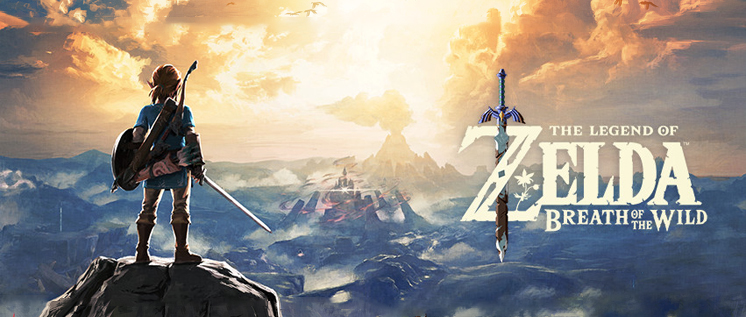
[Content Note: Description of trauma, sexual assault]
Jane (not her real name) was a 13-year-old girl referred to me after being groped multiple times by random peers in the hall at school while visiting her locker between classes. As a result of Jane's traumatic experiences, she was afraid to go to school, walk in the halls, visit her locker, or be home alone, and she was becoming increasingly dependent on her parent.
Although Jane's school staff was supportive of her, they felt there was not much they could do to protect her from future instances.
Jane came to our first several sessions wearing pajamas, often with a hat on and the brim over her eyes. She shared with me that she wore her hat to avoid potential social contact.
Like with nearly all clients I encounter, I asked Jane about what she liked to do her free time. I like to capitalize on clients' skills and interests to help them meet treatment goals. This often initiates a conversation about video games when they're of interest, and it turned out Jane loved to play Legend of Zelda: Breath of the Wild (rated 10+ years) on her Nintendo Switch. Even though she was bashful in our first session, she positively lit up when we talked about gaming. I could see her physically relax. I met the real Jane in that moment.
Link, the protagonist of the game, was a great character to apply in Jane's situation. Link is granted special abilities via the Triforce - a magical artifact that allows him to be powerful, wise, and courageous. In the Legend of Zelda games, Link battles to preserve the country of Hyrule. In Breath of the Wild, he wakes from a deep sleep to re-discover himself and his story, returning to his role as the warrior who battles with the queen of the land to preserve the balance of the Triforce.

Link and the Triforce in Zelda: Breath of the Wild. Source
In Jane's situation, it was clear that her courage and power were taken from her. Her healing journey mirrored that of Link's, re-discovering herself and her autonomy. Our main work focused on how she could embrace her inner Link, arming herself with her mental Triforce and entering school emboldened by a new persona she carried on the inside. I encouraged her to find a physical reminder of Link, whether it be a bracelet, a small token she could carry in her backpack, or a symbol to draw at times when she felt weak or anxious. I encouraged her to find her own protective measures since school left her wanting. She advocated with her teachers to visit her locker at less-frequented times until she was more comfortable and kept with friends whenever possible. We discussed her ability to play the game as homework, finding inspiration in Link's adventurousness and exploration. Link often faced challenges at night, trying to find safety in warm places where he could rest protected. We used this analogy for her to create her own safe space at home when she was alone, so she understood the barriers between herself and the frightening world outside.
In the end, Jane's transformation is one I will never forget; it was both physical and internal. One day, several sessions in, she came to see me dressed in bright, colorful clothes that were a stark contrast to the subdued, baggy pajamas she had worn before. Instead of her typical hat, she wore her hair styled - and with a brave new haircut. In the side-shave of her new 'do, she had the Triforce cut into her buzzcut. It was a statement few could miss. She smiled, showing off her new purple lipstick. She walked with purpose and her head held high as she entered my office. We celebrated her ownership of herself, her courage, and the wisdom she gained in her process. Her parent reflected how she was back to her old self: bubbly, happy, unabashed. She walked her school's halls feeling more in control of herself, able to have a say in her journey.
Legend of Zelda: Breath of the Wild game trailer.
I think much like how we approach clinical interventions in general, it is inconsiderate to the client to only use one method to help them achieve their goals. Therapists have been trained in many ways to consider mental illness and to help facilitate change - it is incredibly important to personalize what we do with clients, so we can meet them where they are and help them find their own growth. Games can be another tool in the theoretical tool box, a useful antidote against suffering that can improve lives. Proper use and intentional application of games are the key to doing this properly.
Games unlock the door to exploring new selves, connecting with stories, and practicing skills like social connection, patience, and ingenuity. The way people mentally approach games is unlike how people typically approach therapy; it is an invaluable way to allow for a curious, open headspace that builds rapport and takes down internal walls. Of course, proper psychoeducation about regulation of play time is key to helping clients lead balanced, healthy lives.
Takeaways / Pro Tips for Therapists
- Be open and curious about games, regardless of how much you know. Your clients can be your guides, and will be expressing their passion at the same time.
- If you are new to game content a client brings into therapy, do a quick online search to find a thorough explanation.
- Don't assume it's mostly your male or teen clients who enjoy gaming. In fact, adult females make up a bigger proportion of the gaming community than teen boys!
- Try to elicit clients' own ideas when setting goals: they have creative ways to integrate game content if you don't have suggestions!
- Don't assume you need a console to engage in gaming therapy. There are tons of ways to apply games without any devices in the therapy room. You could:
- Have clients draw their avatars and discuss their choices
- Discuss game narrative and clients' interpretations of the story, including how they apply it to themselves
- Assign homework for clients to play games with targeted objectives
- Have clients record their play on Twitch or by camera for in-session review, or watch videos of others playing the game online
- Nearly all games have an underlying message of overcoming adversity, always a great discussion topic
- Using Legend of Zelda: Breath of the Wild:
- Capitalize on the mobility of the Switch and have clients bring their game to the session to show you how they play!
- Discussion concepts:
- Adventure, exploration, and new experiences
- Power, courage, wisdom, and the balance between them
- Teamwork
- Self-understanding (Link wakes from a coma and has to re-discover his story)
- It takes a village: Link cannot defeat the enemy on his own. How do clients relate? What are their supports? How do they find more?
__________
About the Author

Sarah Hays is a mental health provider and passionate geek therapist — she integrates the anthologies and play of comics, video games, board games, and movies into her therapeutic interventions. She works in private practice in the Seattle area, recently graduating from the University of St. Thomas' Counseling Psychology doctoral program. She also directs psychological operations for Recovree, a MN-based startup creating a telehealth app to help peer recovery specialists connect with their clients about maintaining sobriety. Sarah specializes in LGBTQ+ care, dual diagnosis, geek therapy, and technology and its advancement of the psychological field. Learn more about Sarah at https://sarahhayspsyd.com/.
Mental Health in Games: 3 Design Tropes that Need to Die
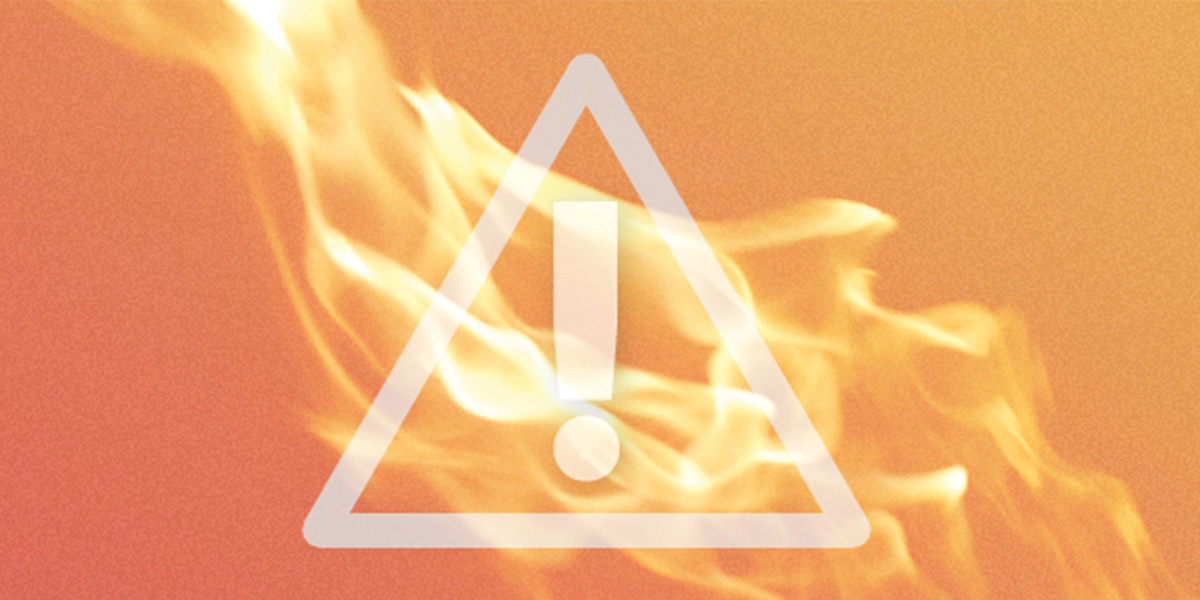
In honor of Mental Health Awareness Month, let's talk about how mental illness is represented in video games and why that should change.
About a quarter of commercially released video games include characters with symptoms of a mental illness. Too often, these portrayals follow the trends we've seen in over 40 years of research into film and television: they tend to be negative, exaggerated, and inaccurate. Since stigma is a major obstacle to seeking treatment and is a known risk factor for poorer mental health outcomes, stereotypical and exaggerated depictions in media can be especially harmful.
[Related: Hellblade: Senua's Sacrifice - Why the World Needs a Hero with a Mental Illness]
Video games can do better. Games are not just a reflection of cultural values, they have the power to shape those values in return. So, for you game designers out there, here's a brief list of 3 common mental health tropes that you have the power to — and should — kill with fire.
The Homicidal Maniac
The Homicidal Maniac is a character trope that inseparably ties mental illness to violence. This character is often portrayed as an evil, ruthless, unfeeling, untreatable, and blood-thirsty killing machine whose traits and behaviors are explained only by some ill-defined mental illness.

According to a 2012 article on IGN, "...there are eleven well-known video game characters that display a special kind of crazy. Why eleven? Because we're crazy, too." Source
- Character examples: Vaas Montenegro (Far Cry 3); Sander Cohen (Bioshock); Kefka (Final Fantasy VI); Nolan Stross (Dead Space 2)
- Why the trope needs to die: Depicting people with a mental illness as inherently violent is the most common way television, film, novels, and even the news "address" mental illness. Characters with a mental illness in movies are far more likely to commit violence than characters without a mental illness, and the rate at which these fictional characters commit violence is grossly overrepresented compared to real-life statistics. In reality, people coping with a mental illness are 10 times more likely than the general population to be victims of violent crime, and 14 times more likely to be the victims of violence than the perpetrators of it. Not only does this trope perpetuate the stereotype that people managing mental illness are violent, but it's also —in this author's opinion- an uninspired and cliched way to approach writing and character development. Do better!
Completely Incomplete: The Symptoms as Character
These depictions take the most visible, non-violent symptoms of mental illness — such as disorganized speech and movement, delusions, hallucinations, and paranoia — and flatten them into a one-dimensional, straight jacket-wearing, babbling, rocking-back-and-forth-in-a-corner caricature. These characters are not whole people, only symptoms personified. The symptoms become the character.
- Character examples: Suicidal Marine (Halo 3); Cicero (Elder Scrolls V: Skyrim); The Mad Hermit (Dragon Age: Origins)

A marine NPC in the Halo 3 level Floodgate talks to himself while pointing a pistol at his head after a traumatic encounter with The Flood, the intergalactic space zombie antagonists of the Halo series. Image source
- Why the trope needs to die: Not every character with a mental illness needs to be as rich and complex as Hellblade's Senua, but if there's time to create a background NPC who exhibits symptoms of mental illness, there's time to make sure that that portrayal is not stereotypical, cliche, or harmful. People who are coping with a mental illness are already often reduced to single words — depressed, schizophrenic, bipolar — and the concept that "you are your disorder" does not need to be perpetuated in spaces that are intended for relaxation and recreation. Normalizing caricatures or extremes of mental illness perpetuates people's misconceptions about what mental illness is and looks like.
Hellish Psychiatric Settings (and Psychiatrists)
There is nothing inherently wrong with using a psychiatric facility as a setting for a game. Unfortunately, however, these kinds of institutions, as represented in games, are almost always places of tragedy and trauma. They are often depicted as ominous and creepy with ephemera strewn about, including straight jackets, scary-looking medical tools, padded walls, and medieval-like restraints. They are frequently used to convey to the player, in shorthand, that the player should be afraid. Have you, as a player, ever spawned in a psychiatric facility and had something good happen? Chances are, probably not. Media portrayals of mental health professionals, either practicing in psychiatric hospitals or seeing clients in a downtown office, tend to evoke similar negative stereotypes of therapists as frauds, quacks, or wildly unethical people.
- Game examples: Manhunt 2; Batman: Arkham Asylum; Outlast; The Evil Within; Grand Theft Auto V (especially Dr. Friedlander)

The Evil Within opens with detective Sebastian Castellanos investigating a mass murder at a local psychiatric facility. Image source
- Why the trope needs to die: This trope preys upon culturally established stereotypes about what a psychiatric hospital represents and the kinds of people that provide and utilize that service. There's no denying that mental health care in psychiatric facilities has a long, troubled, and sometimes horrific history. The Town of Light is a beautifully disturbing example of a game that explores that history well. For many, the thought of seeking treatment — especially in a psychiatric hospital — can be a scary prospect, and many who have spent time in these kinds of hospitals may find the experience frightening. Ultimately, however, the goal of these institutions is to help people by providing intensive and specialized care. Unsurprisingly, portrayals of psychiatric hospitals are most frequently found in horror games because they so easily serve as an affective schema — an emotional shortcut — for conveying a sense of fear to players. I would strongly encourage any game developer who is considering using a psychiatric hospital as a setting, especially in a horror game, to carefully evaluate the necessity of such a setting and whether or not it perpetuates the misguided and harmful perception of treatment centers as Hell-on-Earth.
Why Kill these Tropes with Fire?
If harmful portrayals of mental health can influence how players perceive mental illness, doesn't that imply that exposure to extreme violence in games influences how players perceive violent acts? Not necessarily.
It is well-established and widely accepted that violence is not socially acceptable. We teach children from a very young age to use their words rather than their fists. Engaging in aggressive acts in school is frequently met by ostracization from peers and punishment from adults. Workplaces have defined rules and guidelines about behaving aggressively in the office and often back them up with severe consequences. In short, the concept of thou shall not kill, steal, or harm others is deeply ingrained in our personal values and social reality - the social norms are very clear. We know hurting people is wrong no matter what a video game depicts.
This same reasoning does not apply to mental illness. Other than having a friend or family member with a mental illness, the number one place a person will come in contact with mental health content is through mass media (film, tv, games). Because mental health continues to be stigmatized, we as a society find it taboo to talk about. A lack of open, respectful conversation leads to facts being obscured and misinformation and stereotypes being propagated.
But games can help to change this. By being more mindful of the types of mental health representations they use, game designers have an opportunity to challenge the damaging, persisting beliefs and stereotypes many hold about mental illness.
Co-op Therapy: Using Video Games to Connect with Teen Clients
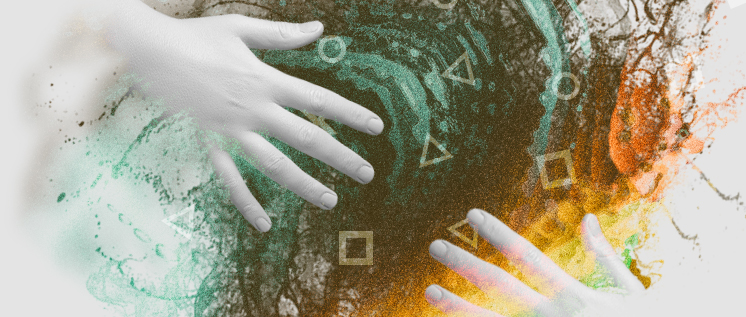
In my therapy practice, I've found that the best way to reach a client is by speaking his or her "language." When it comes to talking to teens, I don't just mean speaking English or Spanish. I mean speaking fluently about the latest trends, songs, and games.
I once worked with a client who did not want to participate in therapy at all. He just sat there. This is not uncommon, especially for teens brought to therapy against their wishes, but I had some ideas on how to help him open up. I was an in-home therapist at the time, so I was able to observe this client's home environment and easily find things in it to ask him about. In this case, what I chose was the client's GameCube. I asked him about his favorite games and whether he'd be up for playing one of them together. He ran and grabbed two controllers.

Nintendo GameCube, 2001. Image source
We played Dragon Ball Z: Budokai, a fighting game. I was excited to play because we both loved "Dragon Ball," an anime (Japanese cartoon) about martial artists saving the world. The first time we played, I won and he reacted with some playful trash-talk — "Oh, I'll get you next time!" — and we both laughed about it. He seemed to be having fun until I won again.
I noticed he seemed to be getting angrier every time I won, so after a few games I let him win. He became obnoxiously excited, taunting and teasing me for losing. I realized he could benefit from working on social skills and emotion regulation, things that were not on his treatment plan. Stepping into his world by playing a game he loved revealed to me several issues that needed to be worked on to help him thrive, things that previous observation had not brought to light. Finding these things out was a net positive, but continuing to play a game in a way that triggered angry or obnoxious responses was not going to help. So I decided that we would play together, not against each other.
My client didn't have any cooperative games — ones where we could play on the same team together — so I stopped by a Gamestop and picked up some used games for him to choose from. The one he wanted to play was Star Wars Rogue Squadron III: Rebel Strike, which also happened to be one of my favorite games.

Players work together to take down a Star Destroyer. Image source
Rebel Strike is a space-combat simulator set in the Star Wars universe that includes a cooperative 一 or "co-op" 一 mode that would let us play together rather than against one another. This was a great game for us to play because it has no versus mode (a gameplay mode where players compete with each other), only a "story mode" where the roles are equal and the play cooperative. Everything we did would help each other progress toward the goals of each mission. When we started playing, my client didn't seem to understand what was going on or what we were supposed to do. This was a great opportunity for me to fly ahead of him and ask him to follow me. It allowed me to teach him how to play, what the buttons did, and what the objectives were. I was able to be supportive and provide guidance in a way that he was open to.
Once he got the hang of things, we played the game as intended: Take out enemy TIE fighter ships and turrets and explode the Death Star. The important thing is that we did it together. We weren't competing anymore. It didn't matter who shot down more TIE fighters or destroyed the most turrets because ultimately we both won. This was very different from playing against each other in a fighting game.
These experiences helped build our therapeutic relationship; my client understood I was on his team and he began to open up to me while playing.
A few years later in my private practice, I had another client who did not want to open up at first. I asked him about his favorite things to do and playing video games, especially Minecraft, was at the top of his list.
Minecraft is available on many devices, so I was able to explore different ways to integrate it into our sessions. We started with the mobile version. My client had Minecraft on his phone and he asked if he could play during a session. It wasn't ideal because he was playing on his own and it seemed like his way of getting out of being there. So we tried a few different things. We agreed that he could earn game time at the end of the session if he participated. This often works with younger children but it turned out it wasn't a good fit for this teenager. He figured out quickly that he could sit silently for the entire session, or at least until it was time to play.
I tried the opposite approach and let him play at the beginning of the session for a set amount of time, during which we could talk about what he was building. Having something in common to talk about and something else for him to focus on while we talked helped establish a relationship, to lower some of his defenses, and to move toward more open sharing. A tentative peace treaty had been reached.

"Playing together - and not against each other - built trust, and I was able to show my teen clients that I was there to support them using their language."
It wasn't until we started playing together that we began to really make progress in building rapport and working toward our goals. I had an Xbox 360 in my office, so we were able to jump into a Minecraft world together. This is something my client was used to doing at home with friends and family and I immediately noticed that he was more relaxed and he seemed more comfortable with this setup. It was great to see that he was in his element. Exploring a world together, walking through the same space, we were finally able to communicate clearly. Maybe it was the setting, the fact that he trusted me now, or both, but we were finally able to get to work on our treatment goals.
In both of these examples, games were the client's preferred "language." Playing together — and not against each other — built trust, and I was able to show my teen clients that I was there to support them using their language. Using play and games in therapy to facilitate skill building and rapport is well documented, and video games are one digital extension of that approach.
For any mental health providers interested in using games, here are three quick tips for using games in therapy with teen clients:
- Use games as an icebreaker and relationship builder: Asking about games teen clients like can be a great way to kickstart a therapeutic relationship with them. Demonstrating a genuine interest in something a teen is passionate about is always a good way to build rapport, whether it's games, books, or something else that you both like. For me, both talking about and playing games in therapy has been a great way to help my teen clients feel relaxed and trusting enough to talk to me and become open to addressing challenges.
- Use gameplay as a window into habits and behaviors: Games can bring out behaviors or difficulties you may not otherwise see in action and can serve as a jumping-off point to work on developing adaptive skills. Games let players face defeat and frustration in a pretty low-stakes way. Those difficult emotional experiences are great opportunities to connect and work on building awareness and skills.
- Mine games for their personal meaning to your clients: Not everyone has the resources or the know-how to have a dedicated gaming console in the office, and that's okay! Asking questions about what games teen clients like to play, giving them space to relive fond gaming memories, and analyzing the themes or narratives in a game can provide great insight into a teen's internal world.
__________
About the Author

Hellblade: Senua's Sacrifice – Why the World Needs a Hero with a Mental Illness
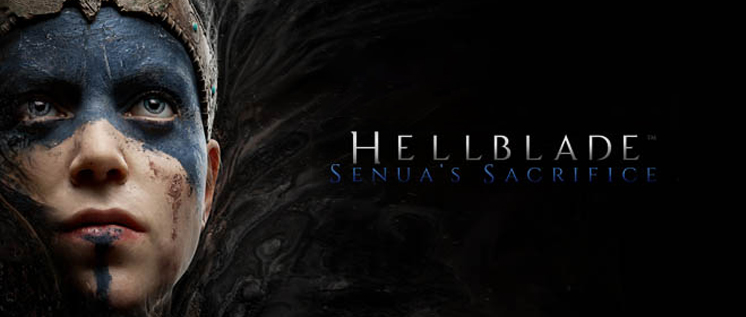
Editor's note: This guest-authored post is part of iThrive's series on games and mental health. Articles in this series reflect iThrive's commitment to use and design games in support of teens' mental health and well-being, both within and outside of traditional therapeutic contexts.
Talking about mental illness can be difficult, confusing, and sometimes even scary. Many people first learn about mental illness from what they have seen on screen and from stories they have heard. However, relying on media portrayals of mental illness can leave people unprepared to empathize with someone coping with one since such portrayals are often exaggerated and promote harmful stereotypes. Independent video game developer Ninja Theory aims to change that with their latest and most courageous title, Hellblade: Senua's Sacrifice (rated 18+ years), whose heroic protagonist is no stranger to mental illness.
Senua's Quest
Hellblade: Senua's Sacrifice is the story of a young woman named Senua on her quest to save her slain lover. As she journeys through Helheim, the land of the dead from Norse mythology, Senua battles monsters, gods, and her own inner demons. If this game had been developed with only this premise it would have been intriguing enough, the gameplay would have been smooth enough, and the graphics beautiful enough to make it as entertaining as many other AAA games. However, developer Ninja Theory wanted to try something new.
In a behind-the-scenes interview, Tameem Antoniades, the Chief Creative Ninja of Ninja Theory, confirmed Senua suffers from "anxiety, depression, hallucinations, and delusions." To best capture what it is like for people who cope with these conditions, the developers worked with Professor Paul Fletcher, a psychiatrist and professor of health neuroscience at the University of Cambridge. The developers also worked extensively with people who had experienced psychosis and integrated their perspectives into the game. With guidance from both professionals and people with lived experience, Ninja Theory was able to create a detailed, immersive, and scientifically informed adaptation of mental illness for video game players to experience.

Senua begins her quest. Image source
In Hellblade, players experience a small measure of what it might be like to cope with severe symptoms of mental illness. For example, as soon as players start the game, they hear a series of voices telling them to turn back, questioning their every decision, and whispering worries of impending doom. These unsolicited voices warn, deride, guide, and encourage Senua throughout her quest. The audio was specifically designed so players would feel like the voices were whispering in their ears or circling around them, making it feel like the voices were in the player's own mind.
Several other aspects of the game were modeled off symptoms of severe mental illness. For example, the game requires the player to solve a series of puzzles to advance. To solve these puzzles, the player must find specific patterns in the environment. It is common for people coping with psychosis to see patterns where there are none, and this game mechanic was specifically designed to reflect that experience for the player.

Senua pieces together runes. Image source
Why We Need a Hero with a Mental Illness
The portrayals of persons with mental illness in movies, on TV, and in video games often feature disturbed, violent individuals and cackling villains. It's much harder to remember a hero with mental illness than to name scores of mentally ill villains. In Otto F. Wahl's 1995 novel, "Media Madness," he describes mentally ill characters as "more likely to be presented as villains than as heroes" (p. 66). Any "crazy," "psycho," or "schizo" villains are written to have originally been law-abiding and peaceful citizens who only become villains after developing a mental illness. This is harmful because it reinforces a social stigma that paints those who are coping with mental illness as dangerous, untrustworthy, or morally corrupt. In fact, persons with mental illness are not only less likely to perpetrate violence than they are to be victimized, they also are 12 times more likely to be victims of violence than persons without mental illness.
However misguided, stories about a pure-hearted and clear-headed hero who triumphs over the insane is how we express a fear of mental illness. Yet, to personify mental illness as a typically irredeemable villain, a being that can only exist in two ways — as maliciously powerful or permanently vanquished — does not inspire a deeper understanding of the complicated circumstances experienced by the mentally ill.
Hellblade confronts this stereotype by offering a character who is living with a mental illness and is also a hero. Her mental illness does not make her less human but instead makes her a more vibrant, complex, and sympathetic character. In other words, Senua is a fully realized character coping with a mental illness rather than a caricature playing out a tired stereotype. By inviting players to engage with a complex, humanized depiction of a person confronting severe mental illness, Hellblade creates a learning opportunity that can move the conversation about mental illness in a more compassionate and mindful direction by prompting players to consider the social stigma surrounding mental illness.

Senua battles Valravn, god of illusion. Image source
What Hellblade Offers Us
When playing Hellblade, players get to see someone with a mental illness as a hero and as someone worthy of understanding and empathy. The game reminds us that people with mental illnesses are, despite marginalization and misrepresentation, whole people. The game also offers players the chance to compare their own struggles with Senua's. We have all, in some measure, experienced anxiety and depressive moods. By playing Hellblade, players are given a chance to think differently about their own struggles with mental health and how they have embarked on their own quests to find redemption, salvation, or simply some inner calm.
For those who have experience with mental illness, but have had trouble communicating their experiences to loved ones, this game offers a helping a hand. One of the greatest challenges when coping with mental illness is the struggle to properly communicate ourselves. Our common language (reflecting how little our society talks about or considers mental illness in everyday life) doesn't have a lot of readily accessible language for us to use to describe our complicated thoughts or feelings. This can leave us and our loved ones confused about the reality of living with mental illness. (Senua had it even worse, only being able to refer to her disorders as a terrifying and mysterious "darkness"). By showing others the depictions of common symptoms of mental illness that we see in Senua, we can show others a glimpse of our struggles and help them better understand us.
Throughout the game, Senua experiences anxiety attacks, flashbacks to trauma, out-of-body experiences, and hallucinations. According to the developers, in their behind-the-scenes footage, she even experiences episodes of compulsive behavior where she cannot to move forward in certain areas of the game until she accomplishes a task or solves a visual puzzle. People who experience any of these symptoms can use this game to show others a compassionate and heroic depiction of their struggles, something rarer and far more helpful than the villainous portrayals we often see in media.
Ultimately, Hellblade encourages players to be more mindful and compassionate of those who are coping with mental illness. Playing this game can help dispel some harmful confusion and stereotypes and give players an opportunity to practice compassion for others' mental health struggles. What Ninja Theory has done is recognized art's use as a form of interactive education and created an opportunity for any and all players to learn more about mental illness, in themselves and others, and stoked the conversation about mental illness and its representation in the media.
__________
About the Author

Courtney Garcia's writing focuses on the practical use of games and other forms of media as therapeutic tools for developing emotional intelligence. She is a lifelong gamer and has experience as a secondary school educator using games to enrich her social and emotional learning curriculum. She has seen, firsthand, the engagement and creativity teens experience when they approach games as educational tools that can boost their well-being, too. Courtney earned her BA from the University of California, Riverside, where she graduated magna cum laude before earning her Masters in Education. Courtney has published research in scholarly journals and regularly writes articles for Screen Therapy, a blog about games, movies, and how we can use them to help ourselves.
Psychology and Game Design: One Possible Future Path
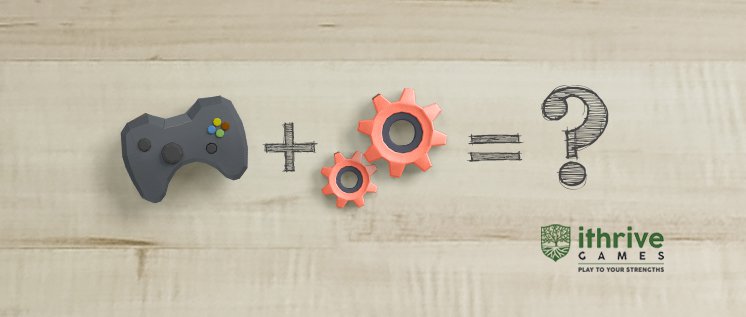
**EDITOR'S NOTE: Ian Schreiber joined iThrive Games for our October 2016 Design Hive, where he learned about our mission and felt inspired to post about it on Facebook (check that out here). This blog is an extension of the thoughts he shared there.
"Is flow the only concept from positive psychology that...help[s] us design better games regardless of our motives for doing so? Or is it just the only one that the game design community has discovered so far?" - Ian Schreiber
It's rare to find a game designer who hasn't studied any psychology. Our job is to craft compelling experiences; understanding how humans experience things is vital to our work.
And yet, much of the field of psychology is devoted to what happens when things go wrong. As with medicine, there is more of a focus on pathology than maintenance or wellness. Most of the training doctors and psychologists go through focuses on how to fix problems, with little attention paid to taking happy, healthy humans and maintaining or improving their health. Much of a game designer's study of psychology, then, focuses on human weakness. When I teach game design in a classroom, for example, I cover topics like these:
- Why most people misunderstand basic probability, and how to design our games' random systems so that they aren't misperceived as unfair (or conversely, how gambling games and some free-to-play games exploit these misconceptions for money);
- Reasons why players are jerks to one another in online games, and how to design our games' social systems to minimize the effects of trolls and griefers;
- Behavioral conditioning, addictive behavior, and other mind hacks that trick players into continuing to play our games long after they would otherwise choose not to;
- Cognitive biases, fallacies, and other traps that our designer brains and player brains lay for us so that they can destroy the fun in our games, and how to design with these very human fallibilities in mind.
This is not to say that these things aren't important. They certainly are. But most players of games are physically and emotionally healthy and well-adjusted humans. Especially if we are designing for the mass market, it would seem prudent to understand not just abnormal psychology, but also the healthy, whole, and thriving mind.
POSITIVE PSYCHOLOGY
The field of positive psychology is concerned primarily with improving an individual's happiness, well-being, and self-fulfillment. Rather than focusing on curing mental illness or eliminating maladaptive behavior, positive psychology seeks ways for individuals to improve their happiness, whether or not they suffer from any disorder in the DSM-V. Here are some examples of concepts studied by positive psychology researchers:
- Empathy: Understanding what others are feeling, and why
- Curiosity: Cultivating a desire to explore the world around us
- Gratitude: Being thankful for the kindnesses of others
- Growth Mindset: Believing that we can improve rather than being limited by our DNA
- Mindfulness: Being present in the moment in a non-judgmental way
- Purpose: Pursuing a life of meaning
- Flow: Challenging ourselves at the peak of our ability
...Wait, what was that last one? It probably sounds familiar, because Mihaly Csikszentmihalyi's work on flow, a key concept in positive psychology that was popularized in games by Raph Koster's Theory of Fun, is standard content in most Game Design 101 classes.
BETTER PEOPLE, BETTER GAMES
Game designers, particularly those of us working on games for entertainment (as opposed to "serious games"), are primarily tasked with making our games fun, to the extent that this will help the games sell enough copies that our studios can keep making games.
I've met a lot of game designers in the last couple of years who seek a greater purpose—far more than I've seen in the 15 years before that. Some of us want to make games that don't just entertain, but that make the world a better place. Not all of us are driven by this ideal, of course, but it seems there are more of us talking about this than ever before.
Even if you're the type of game designer who just wants to make games that are fun and views that as enough of a lifelong challenge without also having to save the world, thank-you-very-much, you've still probably heard of this concept of flow, and maybe used it to improve your games. Not because you want to improve players' lives, but because this concept from positive psychology helps you make games that are more fun. Any lifestyle improvement that happens as a result is a nice bonus, sure, but you wouldn't even bother except that it also makes your games more compelling.
This begs the question: Is flow the only concept from positive psychology that has this property, helping us design better games regardless of our motives for doing so? Or is it just the only one that the game design community has discovered so far?
Given that positive psychology deals with things that improve people's enjoyment of life, it's likely that these concepts would also improve our players' enjoyment of our games. We just need to figure out how. And once we do, perhaps we will enter an age where our best entertainment games do, in fact, make people's lives better. Not because they were designed to do so, but merely because they were designed well as pure entertainment.
If you agree there is potential here, then, consider this your call to action. Join in seeking ways to apply these concepts to game design. I look forward to seeing the better worlds that you create as a result. (If you couldn't guess from the location of this post, iThrive Games is a non-profit organization specifically working in this space, so if you are reading this and thinking that this is describing your
current or future projects, or that you'd like to know more, I'd suggest getting in touch with them.)
***
About the Author: Ian Schreiber (@IanSchreiber) has been in the game industry as a designer, programmer, and educator since 2000. In addition to his role as an assistant professor of game design at Rochester Institute of Technology, he has worked on several shipped titles including online trading card games, console games, online social games, and some "serious games" for corporate training. He is also an author and a co-founder of the Global Game Jam.
Video Games Can Boost Empathy

Note: This article is the first in a series that captures game industry experts' opinions on game titles and mechanics that might boost players' positive habits, mindsets, and skills. These insights arose from discussions at an iThrive-sponsored think tank with game developers and scholars.
Researchers and policy advocates have spent decades tallying the dangers of video games. But there is growing scientific evidence that prosocial video games—those with opportunities to help instead of harm others—can boost players' empathy and prompt them to be more helpful towards others in the real world.
Many games that demonstrate prosocial outcomes in research (Lemmings and Super Mario Sunshine are two examples) were designed first and foremost for entertainment, not to leave players hankering to do good. So the empathy boost captured in much of this research appears to be a happy byproduct of great game design, not—at least not always—an outcome developers deliberately target. It turns out even games with violent themes can prompt prosocial behavior in players who play in cooperative mode.
This made us at iThrive wonder, what other great games already out there might be brimming with opportunities to hone skills and habits that benefit teens? And what would happen if more developers did aim to boost skills like empathy using principles of great game design?
ITHRIVE GAMES' DESIGN HIVES
To gather some insights into these questions, we hosted a think tank ("Design Hive") with six expert video game developers and scholars. These industry experts met with us over a long weekend to trade reflections on games and design features that open the door to positive practices like empathy, even if by accident. We left with a curated list of promising "empathy games," shared below.
We launched the discussion on empathy with iThrive's evidence-based definition (adapted from the work of emotion researcher Dr. Jamil Zaki): Empathy means feeling what others feel, imagining how they view situations, and being motivated to do something with that knowledge. Here's what the developers had to say.
INHABITING THE MEDIUM
One insight permeates the rest: video games are special in the world of media. Games researcher Katherine Isbister (who attended the Design Hive) writes in her book, "At their heart, games differ from other media in one fundamental way: they offer players the chance to influence outcomes through their own efforts. With rare exception, this is not true of film, novels, or television."
The ability to fully inhabit the world of a video game, to embody characters with agency and a chance to impact the world and characters around them, is foundational to many of the experts' other insights about games and empathy. The action in a game, unlike in most other media, is the result of something "I, the player" have done. This stands to make players uniquely invested and immersed in the story before them. And research shows that immersive presence can be linked to increased empathy.
So, from the perspective of "me," the agentic player, these are a few of the ways games offer chances to develop empathy:
- I see other perspectives as valuable currency. In some games, I have to consider points of view different from my own in order to succeed. I must examine both sides of a family feud in Star Wars: Knights of the Old Republic, decide how probing a question to pose to each character in Telltale's The Walking Dead, and interview characters in detective games like Nancy Drew to piece together what really happened. I take my time to listen because missing something important has real consequences for my success.
- I act from different points of view. In games like Never Alone, Brothers, and Telltale's Game of Thrones series, I can switch from one character to another. This lets me see the same world through many eyes and viscerally explore and appreciate each character's unique perspectives and abilities to move the action forward.
- I inhabit difficult circumstances. Even though I may never do it in real life, I can experience the perils of war in This War of Mine and 1979:Revolution, embody someone who is different and marginalized in Dys4ia, see the world through the eyes of a boy with autism in Max: An Autistic Journey, and care for a child with a terminal illness in That Dragon, Cancer.
- I lose someone important. When I lose characters or companions who have helped me or kept me company throughout the game—like in Passage, Fable 2 or Dragon Age: Origins—I wonder if there was something I could have done differently to save them. I have to strategize about what I'll do without them and adapt to their absence. I might feel more empathy for the experience of loss in general.
- I make choices that impact others. In Mass Effect, I choose which character will perform a potentially fatal mission. In Undertale I decide which characters to help and which to fight, and in Papers, Please I find out how willing I am to break the rules to help someone else at a personal cost. In multiplayer online games like World of Warcraft, my choices have an impact on real players. I weigh whether to cooperate or compete, whether or not to share my loot, and learn how it feels when others make these decisions about me. I watch the consequences of my choices play out for better or for worse.
One thing was clear after this session: video games can model and prompt empathy, and it doesn't happen in a vacuum. It helps if players are willing and able to reflect on what they encounter and have the supports necessary to do so effectively. At iThrive, we strive to identify or create the supports that allow games to be meaningful for teens' well-being. But starting with great game design certainly doesn't hurt.
In that spirit, our Design Hive experts recommend 8 games that are developmentally appropriate for teens and may provide opportunities to practice empathy*:
- 1979 Revolution: Black Friday
- Never Alone
- Papers, Please
- Passage
- Star Wars: Knights of the Old Republic
- That Dragon, Cancer
- This War of Mine
- Undertale
Have you played them? How have these or other games helped you or someone you know to develop empathy? Share your story!
Note: iThrive produced the curated games list in a joint effort with expert game developers and scholars. Their recommendations are rooted in evidence-based definitions and examples of empathy provided by iThrive. These games have not been scientifically proven to boost empathy, but they contain features that appear to provide opportunities to develop it.
